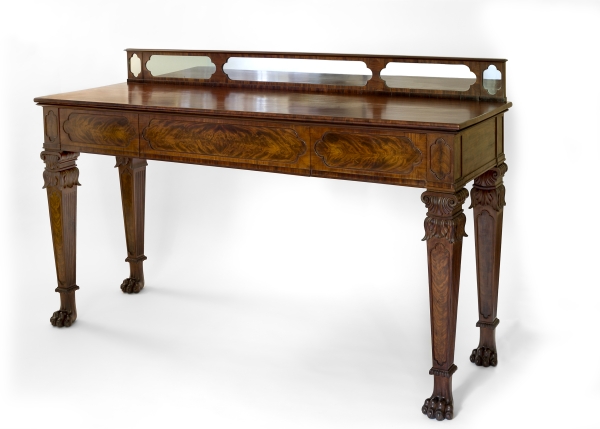· 15 ·
Classical Excellence in Boston:
The Furniture of Isaac Vose, 1789–1825
ROBERT D. MUSSEY JR. AND CLARK PEARCE
In 1782, sixteen-year-old Peter Chardon Brooks (1767–1849) from rural Medford, Massachusetts, journeyed the five miles south to Boston to begin an apprenticeship as a marine insurance broker (fig. 1). He arrived with less than one dollar in his pocket at the end of the Revolutionary War, when economic prospects were poor. But Brooks entered a vastly changed town whose economic, political, and social structure had been overthrown by the expulsion of the old Loyalist elite. The resulting vacuum provided young men like him with unparalleled opportunities to create a new order—and spectacular new wealth. Starting with no taxable assets in 1789, Brooks became a millionaire by the time he was fifty, making him among Boston’s richest men.1 He considered it his “duty” to spend a substantial part of his wealth on “innocent and rational enjoyments,” including the furnishing of his town and country houses.2
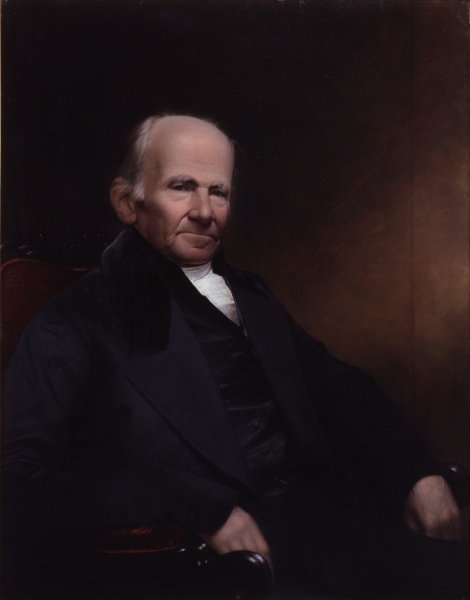
FIG. 1. Peter Chardon Brooks (1767–1849), William W. West, probably Boston, 1852, painted posthumously after an unidentified daguerreotype. Oil on canvas; h 45, w 37. National Park Service, Adams National Historical Park (ADAM 51.9). Photo, David Bohl.
Brooks and many other prosperous Bostonians fulfilled this duty by hiring leading Massachusetts craftsmen. These included Samuel McIntire for interior carving, decorative plaster worker Daniel Reynard, clockmaker Simon Willard, upholsterer James H. Foster, and cabinetmaker Thomas Seymour.3 Over his long life, Brooks developed relationships with these prominent artisans and patronized some of them with unusual loyalty for decades, including cabinetmaker Isaac Vose, who would establish one of Boston’s leading furniture firms in the early nineteenth century.
YOUTH AND EARLY CAREER, 1767–1804
Isaac Vose was born the same year as Brooks, 1767, in Milton, also a small rural town, located ten miles south of Boston. He was among the many artisans drawn by increasing opportunities to move to New England’s capital city from outlying areas. The most talented prospered when men like Brooks, and their fashion-conscious wives, met their perceived obligations to purchase and display the latest styles.
Isaac was born to Samuel Vose (1730–1804) and his wife, Sarah (née Kenney) (1732–1777), of nearby Stoughton. He was a sixth-generation descendant of Robert Vose (Vause), who had migrated to Milton from England sometime between 1650 and 1668.4 Isaac’s earliest years were spent at his father’s inn, the Rising Sun, close to the Neponset River and the various mills at Milton Falls; the river divided the northern end of Milton from Dorchester. Isaac’s mother died when he was ten. His father then remarried, to the widow Katherine (Bullard) Wadsworth, and moved to her former husband’s farm in the southern part of Milton.5 Presumably, Isaac was bound as apprentice cabinetmaker around age fourteen. One possible master is cabinetmaker Nathaniel Bemis of Watertown, oldest brother of Vose’s future wife, Mary Bemis.6 Vose maintained extensive ties throughout his life with the extended Bemis clan and other merchants and mill owners in Watertown. A second possibility is William Wadsworth, a Milton cabinetmaker and probably Vose’s older stepbrother.7
The first record of Vose as an independent cabinetmaker is in the records of the Hollis Street Church in the South End neighborhood of Boston (fig. 2).8 After a fire destroyed the old church in 1787, the congregation employed the aspiring young architect Charles Bulfinch to design a new one, his first commission after returning from a tour through Europe.9 Leading Boston carvers John and Simeon Skillin were paid £66.7.11 for “festoons” on the breastwork of the galleries and “fluted pillars of the Corinthian order.”10 Twenty-two-year-old Isaac Vose billed the church in 1789 for the smallest of all commissions, charging “twelve Shillings, it being for four Contribution boxes.”11 Vose was thus in on the ground floor at the introduction of the neoclassical styles that would dominate in Boston throughout his career.
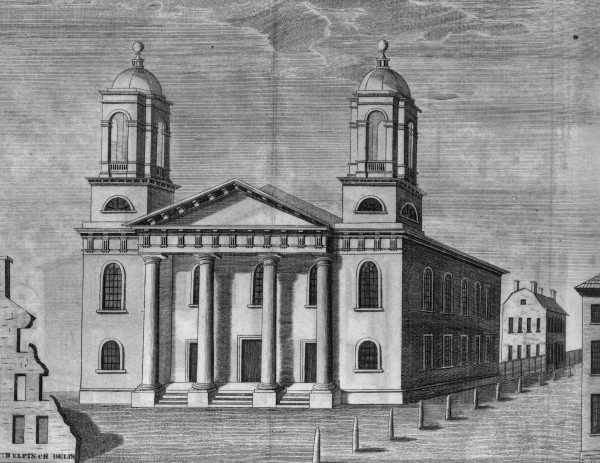
FIG. 2. An East View of the Meeting House in Hollis Street, Boston; / now erecting on the ruins of one lately destroyed by fire, drawn by Charles Bulfinch (1763–1844), engraved by John Vallance (d. 1823). From Columbian Magazine (Philadelphia) 2 (April 1788). Library of Congress.
The Hollis Street Church would prove to be a central focus throughout Vose’s life. Its members came from the entire South End and became Vose’s patrons, business partners, employees, or subcontractors. Some became family to Vose through marriage. Caleb Davis (1738–1797), a long-time deacon and building committee member for the new church, was a wealthy South End merchant and distiller who purchased furniture and repair work from the young cabinetmaker. In 1791, Davis’s order totaling a modest £2.8.0 included a bedstead, a “light-stand [candlestand] top,” “working on a bookcase, bedstead and chair,” “mending a knife case,” and purchase of a pair of “lifting handles.”12
In 1784, the town of Boston was destitute and desperate for increased income to pay off huge wartime debts. Caleb Davis was appointed a member of a Boston Selectman’s Committee to explore increasing tax revenues through granting development rights to the northern portion of Boston Neck. The Neck was a long isthmus barely one hundred yards wide at the northern end that connected the peninsula of Boston to the mainland.13 Davis’s committee recommended a plan to the selectmen by which fourteen pairs of lots would be granted to an association of South End merchant-partners. The development was finally approved in 1786, and after prolonged negotiations, deeds were granted in 1788.14 These became known as the “Fourteen Hundred Foot Lots.” Each pair of lots faced each other across the main road that was renamed Washington Street. Although Davis had been on the town’s committee recommending the development, in 1787 he purchased the northernmost pair of lots, designated as “number one,” from his brother Nathaniel, an original proprietor.15 This appears to have been a “sweetheart” deal, with his brother acting as straw man in the original purchase.
By 1790, Isaac Vose began renting the westerly lot of Davis’s pair (fig. 3). Tax records describe his leasehold as a “Joyner Shop on Boston Neck.”16 The next year, the assessor recorded “Shop. Cabinet Maker boards. Langfords,” indicating that no associated house was yet on the lot. Two years later, two apprentices or journeymen of voting age (one “gone”), “one house,” and “one shop within” were listed. The assessors’ entry in 1793 confirms Vose’s location with the comment “Cabnet Mr. 1st on the Neck.”17 Another original proprietor, the merchant and Hollis Street Church member William Dall, built his fashionable house directly across the street from Vose and rented out a store just to the south.
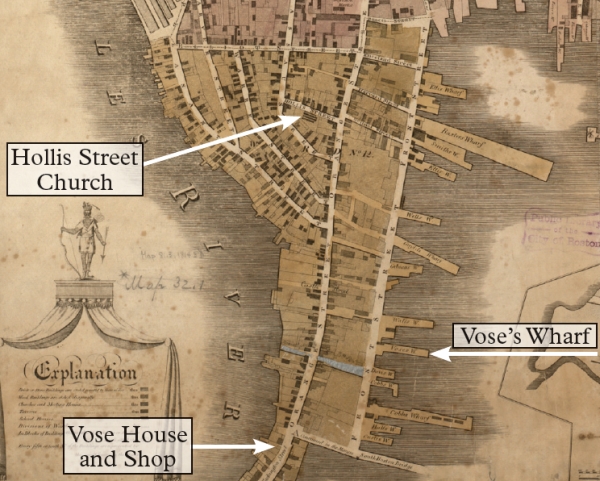
FIG. 3. Detail of Map of Boston in the State of Massachusetts, surveyed by John Groves Hales (1785–1832), engraved by Thomas Wightman Jr. (1782–1820), Boston, 1814. Engraving on laid paper; h 36¼, w 28⅜. The Norman B. Leventhal Map Center at the Boston Public Library. The arrows identify Vose’s house and shop, his wharf, and the Hollis Street Church.
At a young age, Vose showed talent for securing patronage from elite customers. The wealthy merchant Joseph Barrell of Charlestown hired him five times between May 1790 and December 1791, including for “sundry Cabinetwork,” probably for Barrell’s grand new country house “Pleasant Hill,” designed by Charles Bulfinch.18 By 1794, Vose was also working for prominent merchant Stephen Salisbury of Worcester, whose future wife, Elizabeth, was the daughter of Vose’s South End neighbor and fellow church member Edward Tuckerman.19
By 1792, Vose had become successful enough to purchase two pieces of property: farmland in Milton adjacent to his father’s farm and the lot on Washington Street he had been renting from Caleb Davis.20 How was the young cabinetmaker able to acquire the substantial sum of £104 for these purchases? It appears that the money came largely as a dowry paid in advance by his soon-to-be wife, Mary Bemis of Watertown. Just twelve days before Vose’s first property purchase in April, Mary had inherited her first £100 portion due from her father David’s estate.21 Vose had already built his shop and added his house on the Neck property that same year. In 1798, this property was described as having lumber storage (588 sq. ft.), a workshop (800 sq. ft.), and a three-story house (800 sq. ft., with 22 windows), substantial for a young man.22 On December 19, 1792, six months after his purchase of the lot, Isaac Vose and Mary Bemis were married in Watertown.23
AN ENDURING PARTNERSHIP: VOSE & COATES, 1804–1815
No account book, waste book, or letters survive for Vose, nor has any of Vose’s furniture from his first seventeen working years (before 1807) been identified. But a detailed picture of his early life can be assembled from diverse documents. It is clear that he continued to gain clients of wealth and social standing. He made three beds in 1798 for John Codman, Esq., including “1 large bedstead with oppen work sides $10.50 . . . [and] 2 sett teasters” for these, painted green.24 John Sprague, Esq., placed an order for unspecified “Cabinet Work” totaling $21.18 in 1795.25 Throughout the 1790s, Vose purchased a variety of yard goods from wealthy merchant John Amory and the firm of Cutler and Amory.26
Vose boarded his increasing numbers of apprentices and some journeymen in his house from 1793 through 1806.27 Voting “Polls” enumerated at his property grew from two in 1792, to four in 1794, and six in 1800, although the numbers fluctuated. For several of the years between 1795 and 1803, Vose’s younger brother Stephen worked for him as journeyman cabinetmaker, later as mahogany purchasing agent.28 A few of Vose’s journeymen in these early years went on to become noted tradesmen.29 However, most of Vose’s workers labored on in obscurity, working a year or two before moving on to other shops in Boston or other cities.
Immigrant William Piquot (Pico, Peco, Pequot) was a prominent exception, working for Vose as journeyman cabinetmaker for most of the years from 1803 to 1825.30 Piquot was born in France, one of only four furniture craftsmen from that country identified as living and working in Ward 12 from 1789 to 1830.31 Boston had long been “anti-Papist,” sentiments reinforced by Federalist fears of Jacobins during the French Revolution. Piquot’s twenty-three-year tenure with Vose was extremely rare for this period of fluid changes in the trade.32
Joshua Coates’s (1774–1819) twenty-one-year tenure was only slightly shorter. A native of Darlington, County Durham, Great Britain, he was first recorded in 1798 as a journeyman cabinetmaker working for Vose.33 By 1805, they had allied as partners, working as Vose & Coates.34 Their partnership endured until the latter’s death in Boston in 1819, far longer than Boston’s typical one- or two-year alliances.35
Vose’s patrons from the upper ranks of merchants and professional men multiplied. Peter Chardon Brooks was not alone in the accumulation of fortunes, although his was among the largest. David Sears Sr., Nathan and Samuel Appleton, Benjamin Bussey, Edward Tuckerman, Samuel Parkman, Elisha Ticknor, and Samuel Eliot were also showing a Midas touch in a variety of mercantile pursuits. All later became Vose’s patrons. His fortunes increased as theirs did, though on a smaller scale.
As the number of children born to Vose and his wife, Mary, increased, the number of journeymen and apprentices he could board in his home decreased.36 Beginning about 1800, tax records identify many of them as living in houses or tenements owned by William Dall, who was to become a business partner and associate of Vose. These included rear extensions to Dall’s own house at Lot No. 2 East, a store with “chambers above” at Lot No. 2 West, and a house to the northeast on Orange Street. Dall rented out rooms at all these properties, frequently to journeymen cabinetmakers and upholsterers, often named or identifiable as journeymen to Vose.37
Vose’s taxable property valuation climbed steadily and was assessed at $10,500 in 1803. The next year, Vose caught the fever of the day for property development and joined a group of twenty-four South End developers to form the Front Street Corporation. Most of the proprietors were also members of the Hollis Street Church and included Dall, his neighbor. Vose was the sole artisan among the group otherwise listed as merchants or “esquire,” giving an estimate of the respect afforded to him. The town granted the corporation the right to fill out into the waters of South Cove to the east of Washington Street and required the partners to build the new Front Street (now Harrison Avenue). They backfilled behind this area to create “made” land and developed these lots with houses, stores, and wharves.38
Explosive real-estate development and speculative fever spread into South Boston, providing impetus for the construction of a new bridge in 1804 to lessen the distance from Boston. The bridge terminated on Boston Neck, directly opposite and one lot north of Vose’s shop and house, a prime location adjacent to a heavily traveled route.39 In future years, Vose’s shop would become a destination and was often cited as a landmark in newspaper advertisements. The continuous line of ships and wharves along the left side of a lithograph from the period clearly shows extensive baulks (or large beams), planks, and boards piled on decks and in waterfront lumberyards (fig. 4). This was the lumber district of Boston. But as one well-born lady noted in her diary after visiting Vose, the neighborhood was “not a proper place for Young ladies to walk a lone.”40
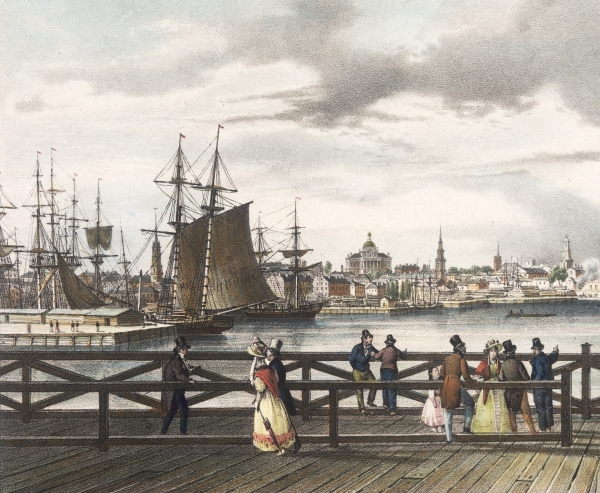
FIG. 4. Detail of View of Boston and the south Boston bridge. From Amérique septentrionale état de Massachusetts, pl. 2, drawn by Jacques-Gérard Milbert (1766–1840), lithographed by Jean Victor Adam (1801–1867), Paris, 1828. Boston Athenaeum.
Vose purchased another property in 1804 on the extension of Washington Street to the north, named Orange Street, probably number 127.41 Its three leaseholds were valued at $3,600 and provided additional rental income. After the death of his wife in 1807, Vose boarded ever-greater numbers of his journeymen in its building(s).42 The long narrow property extended all the way across the tidal “flatts” to its associated wharf at the low water mark along South Cove. This location gave Vose entry to Boston’s lumber district and, after 1804, to a further, highly profitable business—the importation, sawing, and sale of mahogany.
Some idea of the scale of Vose’s imports of this luxury wood is given by a rare surviving survey of mahogany logs he imported in 1809 on the schooner Zebra (fig. 5).43 Former cabinetmaker turned lumber surveyor John Cogswell measured the contents of each of the 150 logs as containing 35,510 board feet for purposes of assessing import taxes. The cargo would have been valued between $7,200 for “Bay” (Honduras) mahogany and $10,650 for the harder, more valuable “Island” mahogany (Swietenia mahogani).44 Vose’s mahogany imports and sales clearly provided him a significant income from at least 1804 to 1825.45 By 1798, he had already built a “wood drying house” adjacent to his shop, which could be used to season this valuable commodity.46
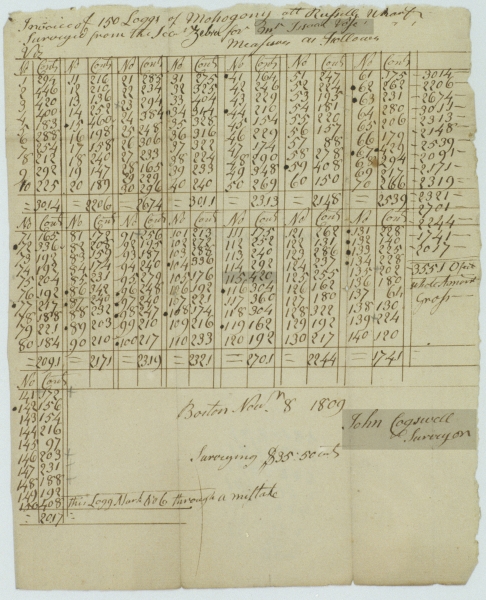
FIG. 5. “Invoice of 150 Loggs of Mohogony att Russells Wharf / Surveyed from the Sc[h]o[one]r Zebra for Mr Isaac Vose,” November 8, 1809. New England Historic Genealogical Society; Sewall-Shattuck Papers. Photo, David Bohl.
Vose & Coates diversified further in 1808 and 1809 when they began direct importation and sales of luxury English and French furnishings. A detailed ship manifest lists nineteen cases they imported, along with three “casks.”47 The contents of some of these are found in the first advertisement placed by the cabinetmakers on December 6, 1809: “Vose & Coates, have received per the [ship] Galen, from London. A large assortment of Looking Glasses; convex Mirrors, and Girandoles, which they offer for sale on reasonable terms.”48 Gilt looking glasses, especially in the latest fashions, were among the luxury furnishings providing the highest profit margins. The casks probably contained hardware, lighting, or other Birmingham metalware.49
By 1810, Vose’s taxable valuation had risen almost continuously to $13,600 for his house, shop with stock in trade, and rental property with wharf. With Vose’s increasingly diverse business activities, in his later career he may have discontinued working at the bench, leaving that task to Coates, who appears to have been a craftsman only.50
Two pieces of furniture survive from this period with firm links to Vose & Coates. Both clearly show the partners could work at a high level of craftsmanship and refinement. A fancy-painted worktable of satinwood and maple is signed “Vose & Coates.”51 It is inscribed in black ink on the underside of a beautifully crafted interior tray and remains their only known signed piece of furniture. The tray’s extremely thin sides are joined at each corner with two thin slips of a dark hardwood (rosewood?), each let into the mitered corners with diagonal saw cuts, then glued and trimmed flush. This technique was used throughout the period of the Vose shops and appears to be characteristic of their work alone in this period.52 Further sophistication is evidenced by the thin, curving stretchers made of three bent-laminated veneers.
Elizabeth Derby, a wealthy divorcée and style maven of Salem, Massachusetts, patronized Vose & Coates in 1808 with a large order for sixteen pieces of furniture totaling $542.50. A wine cooler, charged to her at $32, is the only item in her order known to survive (fig. 6).53 Its oval-shaped tub, now missing the original metal liner, is faced with alternating veneers of crotch-figured light birch and dark mahogany, encircled by polished brass bands. These are supported on turned and reeded legs, with acanthus-carvings at the top in the unmistakable crisp, London neoclassical style of Boston’s finest woodcarver, Thomas Wightman (1759–1827).
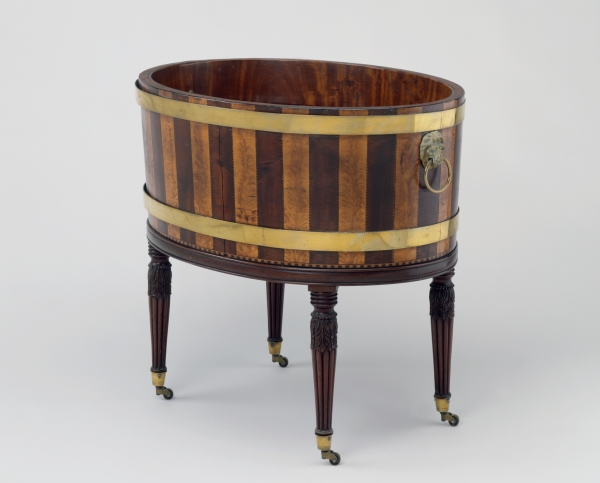
FIG. 6. Wine cooler, Isaac Vose (1767–1823) and Joshua Coates (1774–1819), with Thomas Wightman (1759–1827), carver, Boston, 1808. Mahogany, satinwood; h 28½, w 227/16, d 19½. Museum of Fine Arts, Boston; The M. and M. Karolik Collection of Eighteenth-Century American Arts (39.161).
No other furniture carver working in Boston approached the quality of Wightman’s refined work. His style and workmanship are instantly recognizable. Like Joshua Coates, Wightman was an English immigrant, born in Liverpool. From at least 1780, he lived, trained, and worked in London, where he married and had several children.54 From his immigration to Boston in 1797 until the adoption there of the classical style, about 1815, Wightman’s carving copied his London training and production.55 His designs were precise and symmetrical, deeply incised and sharply outlined. The confidence of his cuts and the perfection of his continuous curves are remarkable. Slight mistakes are rare. Wightman was evidently Vose’s principal subcontract carver at least as early as the manufacture of Elizabeth Derby’s cooler. Their relationship lasted until Vose’s death. In the coming years, Vose would show increasing partiality to hiring many other British-immigrant artisans who could execute the latest British styles to the elevated British standards so preferred in Boston.
Vose & Coates continued to attract the highest ranks of Boston society. Jonathan Mason, a leading lawyer and an original proprietor of real estate development on Mount Vernon Street, Beacon Hill, purchased two large groups of wedding furniture for two of his daughters. When Elizabeth Mason married Samuel Dunn Parker in 1807, Mason’s accounts record the purchase from Vose & Coates of two orders totaling $1,579. When daughter Miriam Mason married the recently wealthy young merchant David Sears, a similar purchase was recorded for $1,577.56
Despite these commissions, Vose’s business diversification proved wise. A series of setbacks in the next years tested his strength. In 1807, one month after the birth of his eighth child, newspapers noted the death of “Mrs. Mary Vose, Aet 38, the amiable and virtuous consort of Mr. Isaac Vose.”57 Vose never remarried. Sometime before 1812, when Vose was appointed legal guardian of his six surviving children, all of them went to live with his wife’s brother Seth Bemis, a mill owner of Watertown, and with her brother-in-law John Richardson, a merchant then of Newton.58 It is likely that Vose’s son Isaac Jr. trained as a merchant-retailer with one of these two relatives. There is no evidence he ever worked as a cabinetmaker.
Predations by the British and French on American shipping also came to a head in 1807 when President Thomas Jefferson declared a total embargo on American shipping to any port in Great Britain. New England maritime and mercantile interests were devastated in the years leading up to and during the War of 1812. Vose was caught in the crossfire. The mahogany brig Joseph, which he co-owned with his neighbor William Dall, was seized and condemned in 1812 by the American privateer Fame just outside greater Boston Harbor on its return from St. Petersburg via Sweden and Liverpool.59 A second ship of Vose and Dall’s was also seized and confiscated, but details are unknown. Restitution for this loss of $4,286 was paid to their heirs only in 1833.60
In 1810, Vose’s reverses continued with the death of five-year-old Charles, the younger of his two sons.61 The same year, the perils of the mahogany trade apparently claimed the life of Vose’s younger brother Stephen. He had probably been acting in Santo Domingo as an agent for Isaac to purchase mahogany and may have returned with a tropical fever.62
Despite the deepening depression caused by the embargo, the Hollis Street Church built a grand new brick building in 1810–11.63 Vose & Coates was paid a substantial $477.58, and Thomas Wightman received $318 for carving work. Both charges were probably for the elaborate mahogany pulpit and carved curtain valance shown in an early photograph (fig. 7).64 Their work also included the creation of the two large and striking mahogany tablets flanking the curtains and pulpit. An early church historian described them as the gift of church member and wealthy Boston merchant Benjamin Bussey. “It may interest you to know that these tables [archaic for “tablets”], still guarding this pulpit, on the right hand and on the left, were made by Messrs. Vose and Coates; the painting executed by John R. Penniman, all of whom were considered the first in their profession.”65 The photograph depicts their near eight-foot height, with arched tops surmounted by large carved sunbursts and flaring, fluted bracket supports with carved winged angels. Their surface appears to be mahogany, perhaps with gilding applied to some carved elements.
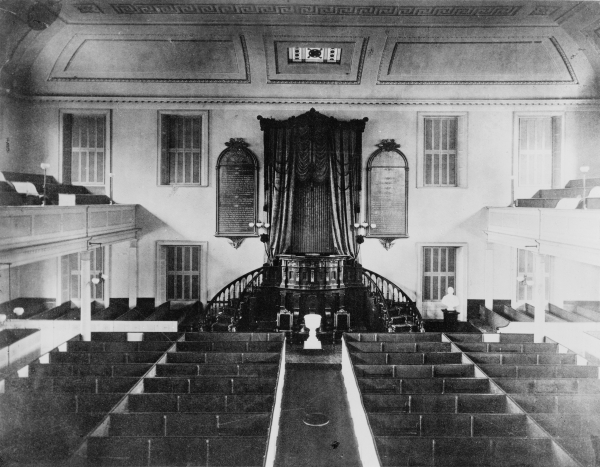
FIG. 7. Interior of the Hollis Street Church, Boston, built 1811–13, with mahogany pulpit, valance, and tablets made by Isaac Vose and Joshua Coates, carved by Thomas Wightman, gilded and painted by John Ritto Penniman (1782–1841). Photograph by Arthur C. Haskell, ca. 1936 of a ca. 1870 photograph then at the Bostonian Society. Historic American Building Survey (HABS, MASS, 13-BOST, 48-3).
John Ritto Penniman’s elegant gilt lettering in Gothic script on the left panel can be read in the photograph: “And Jesus Son of God Spoke these Words, Saying,” followed by the Ten Commandments. A version of the Lord’s Prayer was spelled out on the right tablet. Penniman was recognized as Boston’s finest decorative painter. His studio on Orange Street, only one block from the church, was in the same rented building as that of the young cabinetmaker Thomas Emmons, who with his partner George Archbald would soon become a principal competitor of Vose & Coates.66
Vose’s prominence and standing in his church is reinforced by his purchase for $625 of a deed to one of the most expensive pews in the new church. In the same front-and-center location were fellow members Edward Tuckerman, Benjamin Bussey, John Davis Williams, Barzillai Homes, and General Amasa Davis.67
Vose’s diversification protected him during the embargo and war years, and his tax valuation continued to rise. In 1811, he was taxed for a new mahogany wharf on the Front Street property, which he had acquired in 1804 as proprietor of the Front Street Corporation. The “store and improvements” with lumberyard were valued by assessors at the substantial sum of $4,000. (It is probably one of the wharves with ships tied up visible in an early view of South Boston Bridge [see fig. 4]).68
Other successful merchants who had diversified also weathered the wartime economy and continued to purchase stylish furniture. In 1814, Stephen Salisbury (1746–1829) of Worcester and his wife, Elizabeth (Tuckerman) Salisbury (1768–1851), purchased six pieces for a bedchamber from Vose & Coates for a total of $143.69 Stephen was in partnership with his brother Samuel as S. & S. Salisbury; the latter operated the Boston branch of their business importing and retailing general merchandise. Elizabeth (fig. 8) was the daughter of one of Vose’s South End neighbors, the wholesale baker and international merchant Edward Tuckerman (1740–1818), who owned a South End wharf just to the north of Vose’s shop. He was a leading member of the Hollis Street Church and active in the building of the new church in 1811. It was probably through her father that Elizabeth selected Vose as her principal cabinetmaker.70
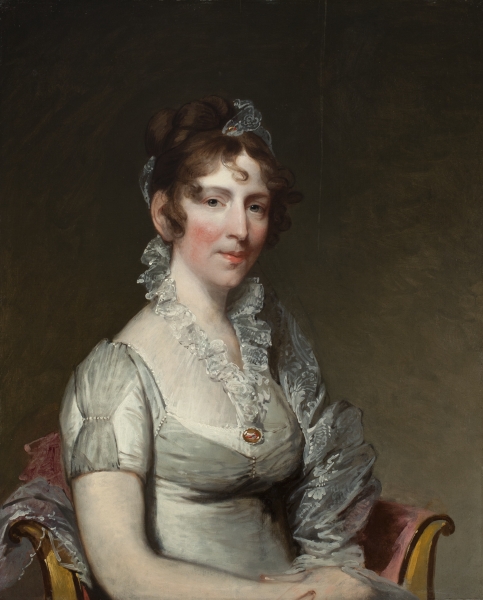
FIG. 8. Elizabeth Tuckerman Salisbury (1768–1851), Gilbert Stuart (1755–1828), 1809–11. Oil on wood panel; h 32, w 26. Worcester Art Museum; Gift of Stephen Salisbury III (1901.29).
Elizabeth Salisbury was an extremely demanding customer. She evidently returned the Pembroke table listed on the 1814 order: a letter from her brother-in-law Samuel Salisbury in Boston noted that “Mr. Vose says he will take back the Table.”71 She also rejected imported lighting purchased from Vose, which she claimed was defective: “I am not at all satisfy’d with our Entry Lamp. . . . If not mistaken, I ask’d him [Vose] if the Lamp I saw hanging (& which I suppose [is the] same we have) was not crooke’d and he told me it was not. At any rate, I stipulated to exchange any thing I was not satisfy’d with.”72
As the wife of a wealthy merchant who indulged her tastes, Elizabeth spent money freely. After selecting chintz with silk ball fringe for bed curtains, she wrote her husband from Boston: “I think it will please you. . . . If you find I have spent too much money, you can punish me by not permitting me to come again.”73 She did come again, writing to Stephen that “when I left home, I had no Idea that I should spend all the money you gave me, but the fact is . . . the money goes . . . but very fast.”74 Vose prospered because of free-spending women like Elizabeth Salisbury, and he understood that satisfying female clientele, the principal buyers of furniture throughout this period, was essential. Many of his customers returned over a period of decades. Evidently his word was good.75
EXPANSION AFTER THE WAR: VOSE, COATES & CO., 1815–1819
After eight years of commercial and economic distress in New England, news of peace finally arrived in early 1815 to great joy and exuberant celebrations. Boston merchants rushed to reestablish credit and commercial relations with their London bankers, suppliers, and agents. Others traveled there to meet demand denied by a decade of war and now lusting for the newest luxury furnishings. Their ranks were joined by twenty-one-year-old Isaac Vose Jr., who had just joined his father’s firm, now renamed Vose, Coates & Co. The young merchant-partner was apparently in charge of imports. He traveled to Liverpool with Joshua Coates in late 1815 to purchase “a great variety of articles in his line of business.”76
The younger Vose had probably just returned to Boston in August 1816 when a newspaper advertisement with the firm’s recent London imports appeared, touting “Elegant Lamps, & Looking Glasses . . . an additional supply of elegant and useful articles of Furniture, viz. An elegant assortment of Chandeliers, Lamps and Candlesticks; convex Mirrors, with double branches; Pier Glasses, Girandoles, and Dressing Glasses of the most fashionable patterns.” They further offered “Rose Wood, gilt and bronzed Chairs of the newest pattens [sic]; seasoned Mahogany of all dimensions kept constantly for sale.”77
In August 1816, John Derby, a wealthy heir and merchant in Salem, purchased from Vose, Coates & Co. “24 rosewood chairs del’d at Salem as agreed, $150,” probably among those just imported.78 The relatively low cost of $6.50 per chair indicates that they were faux grained to resemble rosewood. Vose noted at the bottom of his bill to Derby that “we have retained one of the Chairs for the purpose of doing the Sofa by,” rare proof of his direct adaptation of the latest imported British style. They were probably similar if not identical to a surviving partial set of imported English chairs of about 1817 that were purchased by Boston merchant Nathan Appleton. These are rosewood grained on beech, a typical English furniture wood, and have floral- and leafage-pattern brass inlaid into the crest rails.79
These “newest patterns” had already begun to trickle into Boston just before and even during the war. One of these styles encompassed what is today called “English Regency,” probably first introduced to the town by English immigrant Thomas Seymour. In 1809 Seymour advertised “several articles of a new and elegant style,” probably referring to these Regency innovations.80 Throughout his career, Seymour favored the latest English fashions. These included several pieces he clearly adapted from Regency-style designs published in Thomas Sheraton’s pattern book The Cabinet Dictionary (London, 1803).81
A second style innovation, termed “Grecian” in the period, was based on French and English reinterpretations of ancient classical architecture, decoration, and furnishings.82 Newspaper advertisements in Boston explicitly describing “Grecian” furnishings first appeared about 1811. The alluring description of the Boston Theater that had been recently redecorated by British immigrant actor and scene painter John Worrall is among the earliest. He noted the elements as “tastefully adorned, alternately with a lyre, and wreaths. . . . The figure of Apollo, with the lyre, seated among the clouds upon Olympus . . . ornaments . . . painted in claire obscure with festoons of flowers, over ornaments a la Grecque upon a rich lilack ground.”83
Advertisements for “Grecian” furniture designs appeared about the same time in Boston, beginning with lamps and wine coolers in 1811 and card tables in 1812.84 British immigrant upholsterer William Lemon announced his sale in 1812 of “Grecian Couches, Sofas, Chairs, &c. stuffed in the English and French mode.”85 In the next five years, offerings proliferated with a Grecian appellation for virtually every type of furniture.
The earliest surviving Boston furniture that was explicitly identified as “Grecian” in a period document is a pair of card tables purchased in late 1816 by Peter Chardon Brooks from Thomas Seymour for his Medford country estate, The Elms (fig. 9).86 Their design was undoubtedly based on similar English examples imported into Boston.87 Brooks purchased furniture in Regency and Grecian classical styles, both popular and used together in the interiors of wealthy Boston families. They reflected the generally conservative British taste of Bostonians compared to the more adventurous French fashions then popular in New York and Philadelphia. Local taste preferred “accessories that were distinguished, yet unpretentious, elegant, yet chaste, fashionable, yet not avant garde.”88
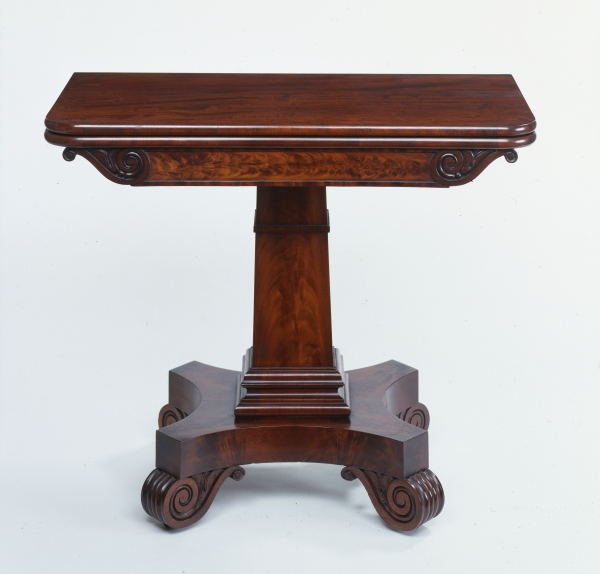
FIG. 9. Grecian card table, Thomas Seymour, with Thomas Wightman, carver, Boston, 1816. Mahogany, Honduras mahogany, ash; h 30⅛, w 49¾, d 18. National Park Service, Adams National Historical Park (ADAM 1). Photo, David Bohl, courtesy of Peabody Essex Museum.
Because Boston cabinetmakers were at first unfamiliar with the new Grecian designs, not every early effort was successful. Two sideboards, for example, made by Seymour and carved by Thomas Wightman about 1815 are awkward in their massive upper cases, which are supported by small-proportioned and curiously carved legs and paw feet (see fig. 25).89 Seymour was unable to capitalize fully from his introductions in the new Grecian style as he had from his English Regency innovations. He had struggled financially during the embargo and War of 1812 years. In 1817, he closed his own cabinetmaking shop after a twelve-year run. For the next two years, he worked as foreman for another up-and-coming local artisan, James Barker and his furniture warehouse.90
Isaac Vose Jr. returned from England in late 1816 with the latest in imported fashions, but Coates stayed on there for a few months.91 Before leaving Boston, Coates formally promised to marry Thomas Wightman’s daughter Maria (1788–1855). The Wightman family had lived directly across from Vose & Coates since 1812 in lodgings rented from William Dall.92 But letters from Dall’s children inform us that Maria learned Coates had married “an old flame” while he was in Birmingham. Maria’s affronted father removed the portrait of Coates that had hung “revered” in his hall but was now an insulting presence.93 When Coates returned to Boston, Maria’s brother, the local engraver Thomas Wightman Jr., avenged his sister more directly, committing assault and battery on Coates.94 The Wightman family moved from their place across from the Vose, Coates & Co. shop to a rented leasehold farther north on Orange Street.95 Wightman continued as Vose’s carver of choice but probably couldn’t bear to live opposite his daughter’s betrayer.96
Despite these dramas, Vose, Coates & Co. continued to add patrons from the growing rolls of Boston’s elite. Harrison Gray Otis (1765–1848) was a leading Boston federalist politician and real-estate developer. He made three substantial purchases from the firm in 1816 and 1817 totaling $835.97 In 1817 and 1818, Charles Russell Codman (1784–1852) recorded six payments to Vose, Coates & Co. totaling $2,600 for furniture for his new house on Chestnut Street.98 Vose’s shop had become a destination of choice for Boston’s wealthy. Mehitable (Sullivan) Cutler Amory (1772–1847) noted in her diary, “Mr. Buckminster and Young [Washington] Alston at Dinner—Mr. A and myself walkd to Voses to look at a side board.”99
The only fully documented surviving furniture sold by Vose, Coates & Co. late in the decade is a pair of tables described on an 1818 receipt from Vose as “2 Mahogany Pier Tables with Marble tops” (fig. 10).100 They cost the wealthy South End wine and liquor merchant John Davis Williams (1770–1848) the substantial sum of $280, out of a total of $980 for a variety of furnishings. Williams was a fellow Hollis Street Church member who lived several buildings south of Vose on Washington Street. His order also included a “Grecian Couch,” a set of “16 Mahogany Chairs in Haircloth @ $17 [per chair],” “10 Gilt & White Chairs @ $6,” “French Andirons,” and two bureaus to be delivered later.
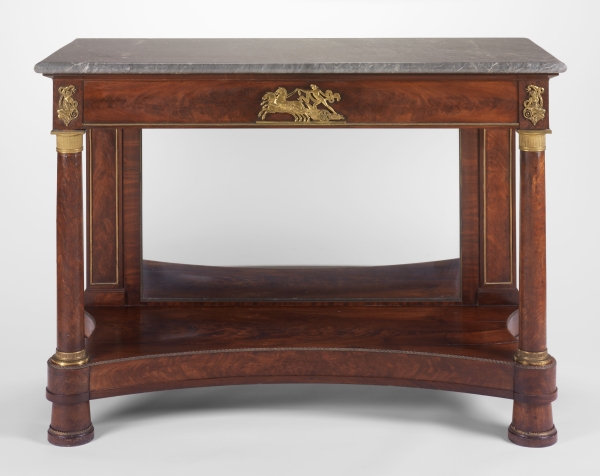
FIG. 10. Grecian pier table, Vose, Coates & Co., Boston, 1818. Mahogany, white pine; h 3513/16, w 49¾, d 22⅜. Rhode Island School of Design Museum; Abby Rockefeller Mauzé Fund (82.014).
The tables are the earliest documented work of Vose, Coates & Co. in the new classical style, and several distinctive methods of construction and ornamentation allow for the attribution of other pieces with shared features. The front and side edges of the lower plinth are shaped with gently rounded, in-curving outlines. The feet are simple, slightly tapering cylinders with a narrow projecting fillet molding at the bottom, adapted from those on imported French furniture.101 The four rails and stiles of the plinth structure are each a single thick board, joined at the front corners with mortise-and-tenon joints and dovetails at the rear. Decorative brass moldings in a leafage pattern are set in rebates bordering the lower plinth and feet. Similar moldings in a rope pattern frame the recessed panels of pilasters flanking the mirror.102
The firm of Vose, Coates & Co. was patronized many times by the merchant Nathan Appleton (1779–1861) for his fashionable town house at 39 Beacon Street, which was completed in 1817.103 His elegant rosewood pier table (fig. 11) is attributable to the firm based on the same distinctive features as the Williams tables.104 Its more expensive wood and lavish use of brass moldings mark it as a costlier version. A photograph from the 1880s shows its gently in-curved front facade and its conforming marble top fit against the bowed wall of the front parlor at Appleton’s house.105 The compressed ball feet with applied decorative brass moldings characterize a group of furniture made in the Vose, Coates & Co. shop as well as in Vose’s successor shop.106 Projecting wood fillet moldings at the base of the plinth are applied around the tight curves of the outset corners; they were made by bending and laminating three thin veneers, the same technique used to construct the curved stretchers of the worktable that Vose & Coates made and signed a decade earlier. Moldings surrounding the apron rails under the marble have a simple beveled profile, a shape found frequently on Vose, Coates & Co.’s work in this early Grecian period.
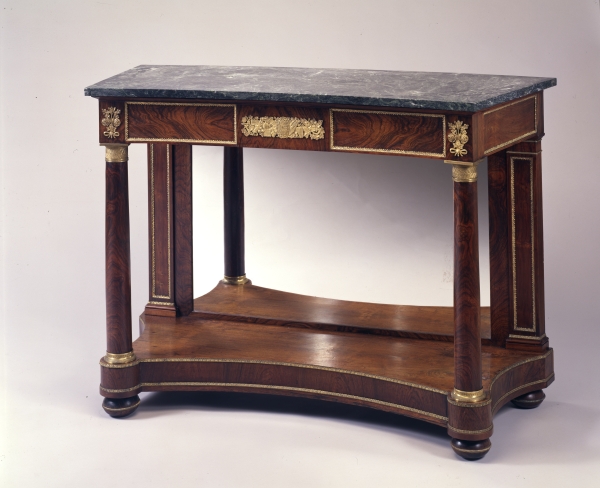
FIG. 11. Grecian pier table, attributed to Vose, Coates & Co., Boston, 1817–18. Rosewood, mahogany, white pine; h 34¾, w 50¾, d 21¾. Historic New England; Gift of Edith Standen and Anthony Standen (1967.138).
Appleton’s purchases for his new house included two additional pier tables closely related to each other but with differing marble tops. The more outstanding of these is from about 1817–19; it employs highly figured branch mahogany veneers throughout and a spectacular “specimen” marble top (fig. 12).107 It can also be firmly attributed to Vose, Coates & Co. based on construction features that are similar to those used for the documented Williams tables. In addition to the array of marble inlays, the corners of the central rectangular panel of black marble have inlaid multicolored butterflies set into white grounds. Appleton might have bought his Italian marble top in Boston or imported it directly, as he did other furnishings. An 1812 advertisement in Boston offered a similar “Pier Table, of Italian marble, inlaid with specimens of each kind in mosaic.”108 The table’s boldly carved claw feet can be attributed to Thomas Wightman.
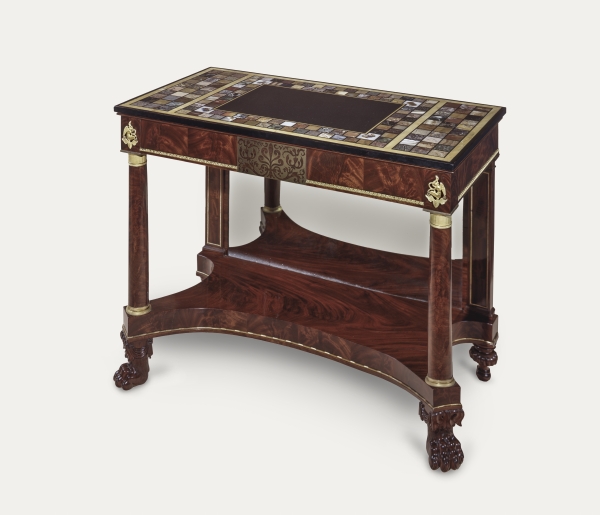
FIG. 12. Grecian pier table with specimen marble top, attributed to Vose, Coates & Co., with Thomas Wightman, carver, Boston, 1817–19. Mahogany, white pine, chestnut; h 35⅞, w 44½, d 23. National Gallery of Art, Washington, D.C.; Promised gift of George M. and Linda H. Kaufman (99.2).
Here, Thomas Wightman’s very square foot design employs a squared band of hanging leafage at the top and a straight vertical rear edge, with his preferred vertical rib of stylized hair at the rear hock. Claws are extremely pronounced and large scale. On the sides, drapery folds are suspended at the front from a curling volute, at the rear from a carved ring. The rear feet are turned and carved with a distinctive wide band of large-scale reeds, a design borrowed directly from ancient classical design sources. The shaping of the sides of the base plinth is more pronounced and asymmetrical than on Appleton’s pier table (see fig. 11), probably indicating a slightly later date.
Also distinctive is the central panel on the front apron rail, which features an applied Boulle-work panel of inlaid brass and rosewood. The precision of its central anthemion and stylized leafage indicates that it would have been imported from the highly specialized industry in Birmingham, England. In fact, every known Boston piece with such panels can be tied to Nathan Appleton and either to Vose, Coates & Co. or to Thomas Seymour. It is likely these panels were among the hardware that Joshua Coates selected while he was in Birmingham, along with his English wife.109
Another pier table that probably also descended from Appleton is similar in most features.110 The principal differences are its use of rosewood and rosewood faux-graining instead of mahogany, the canted front corners on its apron rails, and its plain white marble top with pale gray veining and molded edges. It also has a Boulle-work panel of an identical pattern on the central portion of the front apron rail, but with the brass and rosewood elements reversed. The construction details of the two tables are virtually identical, as is the shaping of the base plinth and shelf. The pattern of the carved front feet is similar but simplified from that of the rosewood table. The distinctive carved and turned rear feet with large-scale reeds are virtually identical on both tables, although the patterns of brass mounts and moldings differ.111
Several photographs taken in the 1880s of Appleton’s Beacon Street house (see fig. 14) show a pair of upholstered Grecian couches in the front parlor that are rosewood grained (fig. 13).112 A second pair of similar design but made of solid and veneered rosewood also descended from Appleton. Only one of these couches survives; it also features brass and rosewood Boulle-work panels.113 Two of three panels on each of these couches employ a pattern similar, but not identical, to those used on Appleton’s pier tables.
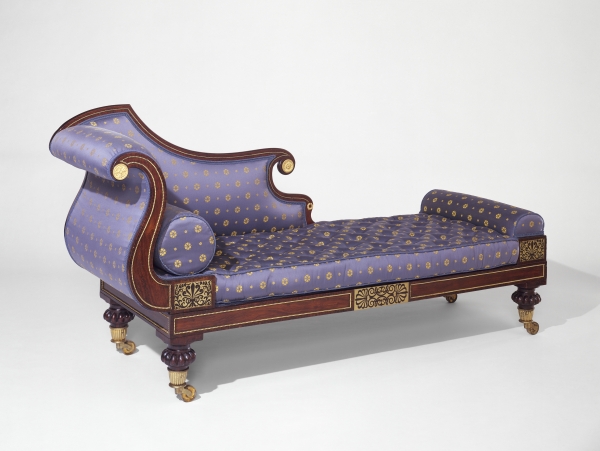
FIG. 13. Grecian couch, attributed to Vose, Coates & Co., Boston, 1817–19. Mahogany, rosewood, birch grained to simulate rosewood; h 34⅞, w 70¼, d 23¾. Museum of Fine Arts, Boston; Museum purchase with funds donated by a Friend of the Department, the William N. Banks Foundation, The Seminarians, Dr. and Mrs. J. Wallace McMeel, and Mr. and Mrs. Edward L. Stone (1977.726).
The year 1818 was a landmark for Peter Chardon Brooks. He noted in his daybook: “Our daughter Ann was married on the Evening of Monday March.2.1818 to Rev. N. [Nathaniel] L. Frothingham, Pastor of the First Church.”114 Brooks detailed his expenditures totaling $4,000 for furnishings for Ann’s wedding gift. Her largest purchase by far was for “Mahogany furniture of Vose & Coates” at a cost of $1,201.50.115 Brooks could well afford it. The previous December, his habitual year-end accounting of his moral and financial net worth showed that his assets had surpassed one million dollars.116
MATURITY AND EXCELLENCE: ISAAC VOSE & SON, WITH THOMAS SEYMOUR, 1819–1825
The Vose, Coates & Co. firm received a shock when Joshua Coates died suddenly on February 28, 1819, after being thrown from a carriage.117 Three weeks later, Vose gave public notice that his partnership with Coates was dissolved and that he had become partners with his son Isaac Jr., operating as Isaac Vose & Son (fig. 14).118 Coates’s probate inventory lists the value of his half of the business as $9,250, an astonishing sum for a craftsman, especially an immigrant who had arrived as a young man with no assets twenty-five years before.119
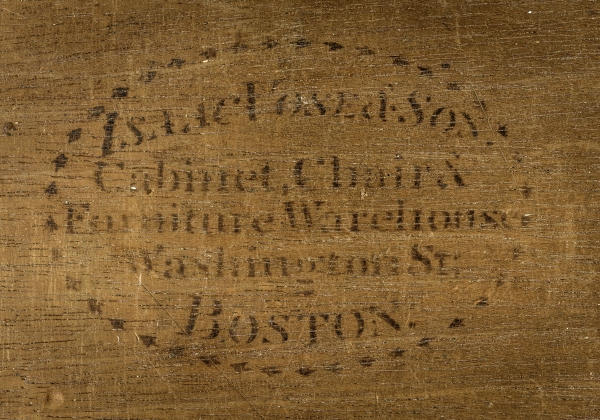
FIG. 14. Stenciled label, “Isaac Vose & Son. / Cabinet, Chair & / Furniture Warehouse / Washington St, / Boston.” from dressing bureau, Boston, 1820–25. Mahogany, probably ebonized maple, white pine; h 69½, w 44, d 24⅜. Winterthur Museum; Museum purchase in honor of Wendy Cooper with funds drawn from the Wendy Cooper Gift Fund and the Centenary Fund (2015.0005). This labeled bureau nearly matches the one in fig. 19.
Just one week later, the first of many prominent advertisements was placed by the new firm. It continued to make “Rich and Valuable Furniture” and had “on hand a Large Assortment of Cabinet Ware, of All Kind, Mahogany and Rose Wood Chairs . . . All orders [received] for Furniture to any pattern,—and for every article in the Upholstery Line.” The long list of imported luxury furnishings included an extensive assortment of “elegant” lighting, imported gilt looking glasses, and, “by the late arrivals from France, a few sets of Rich French Andirons.”120
This initial advertisement also touted the firm’s new “Manufactory of Painted, Japan’d and Fancy Chairs” and announced that “[they] have taken Mr. Joshua Holden, into the concern of that branch of business.” Holden was well known to Vose, having rented lodgings and a workshop at the latter’s 127 Orange Street property beginning in 1812.121 Holden’s productions were probably sold in Vose’s “Chair Store” adjacent to his shop, which he had rented from William Dall beginning in 1814. The Vose–Holden partnership lasted only one year.122
Within two months of Coates’s death, the leasehold at William Dall’s across the street, which Thomas Wightman and his daughter had abandoned, was rented by Thomas Seymour.123 Seymour had worked the previous two years for James Barker at his “Furniture Warehouse,” but that enterprise had failed or was failing by mid-1819, after the death of Barker’s young wife, Ann (née Raymond). Seymour soon shifted his role as foreman-cabinetmaker from Barker’s shop to Isaac Vose & Son’s.124
With the addition of Seymour’s superb skills and his emphasis on craftsmanship of the highest standard, the Vose shop productions took a leap upward in quality of construction and diversity of design. A large number of pieces from this period are either identified by the company’s stencil or documented through receipts or history of descent; still others can be attributed to the shop based on these examples. Seymour apparently also brought along his predilection for attracting a series of talented British artisans who had recently immigrated; their advanced skills further elevated the shop’s standards. The addition of Seymour as foreman only enhanced and expanded Isaac Vose & Son’s status as the destination for fashionable furniture in Boston.
The collaboration of Isaac Vose and Thomas Seymour merged two powerhouses, one with sharp business acumen and the other with outstanding craftsmanship and artistic creativity.125 Seymour’s contribution was the single greatest key to the extraordinary quality of the furniture produced by Isaac Vose & Son between 1819 and 1825, a period that represented the glory days for the shop and for classical furniture in Boston. Vose relished his role as businessman, freeing Seymour to focus on his particular gifts.126
A rosewood Grecian dressing table with mirror (fig. 15) is probably among the earliest pieces produced by the Vose–Seymour collaboration. It bears the stenciled label of the new partnership of Isaac Vose & Son (see fig. 14). Samuel Appleton (1766–1853), Nathan Appleton’s brother and former business partner, reportedly purchased the table when he married Mary (LeKain) Gore (1788–1870) in 1819.127 Although it lacks a marble top, the dressing table serves as a good comparison with Nathan Appleton’s rosewood pier table, which was probably made sometime before 1819 under the supervision of Joshua Coates (see fig. 11). The two relate closely in design and dates of manufacture, yet the dressing table exemplifies the refinements that Seymour brought to the new partnership.
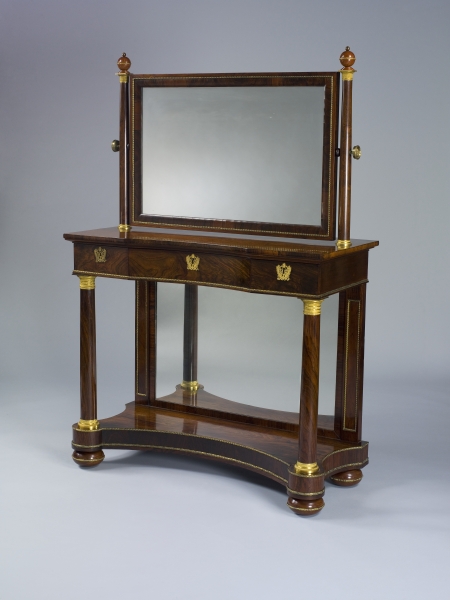
FIG. 15. Dressing table, Isaac Vose & Son, Boston, 1819–22. Rosewood, mahogany, Honduras mahogany, chestnut, white pine; h 62½, w 43¾, d 19¾. Saint Louis Art Museum; Funds given by the Decorative Arts Society (10:1975). The stenciled label on this dressing table matches that in fig. 14.
Both tables employ rectangular recesses lined with different patterns of die-rolled brass moldings. Both have soft curves on the fronts and sides of the plinths, cut in segments of a circle. These gently curved plinth shapes typify the earlier pier table forms made by Vose & Coates. Soon after the dressing table was made, these soft curved plinths were abandoned for a much bolder treatment, with the sides cut deeply in sections of an ellipse. Although these more radical plinth curves may have been introduced under Coates’s tenure with the firm, they became ubiquitous on pier tables made by Vose’s competitors Emmons and Archbald and were adopted by shops across the city. The two tables also share the highly compressed ball feet with die-rolled brass equatorial rings that became common among several Boston shops. The tables’ simple beveled moldings beneath the tops are apparently unique to the Vose shop (fig. 16).
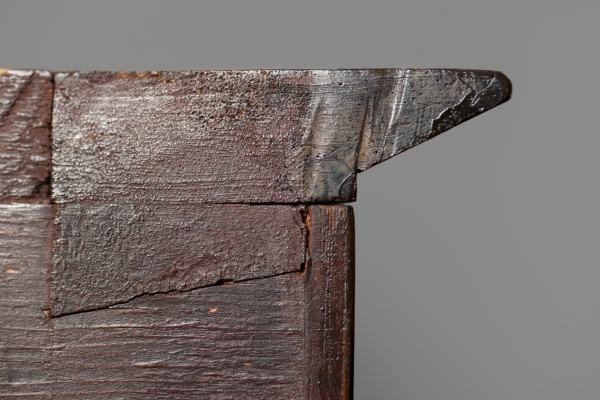
FIG. 16. Rear corner of the pier table in fig. 11, showing broad, angled molding below marble top. Historic New England; Gift of Edith Standen and Anthony Standen (1967.138). Among Boston cabinetmaking firms, only the Vose shop employed this distinctive molding beneath the tops of pier and dressing tables.
The most obvious improvement that Seymour made on the dressing table was the fussy precision of all the joinery and veneer work. The level of finish is high in all places, seen and unseen.128 Even the undersides of the plinth rails are perfectly clean, eschewing the use of pinch-dog clamps (used to glue the fillet moldings to the curved sides) that made the small square holes in secondary surfaces typical of Coates’s work.129
One of Seymour’s great talents was his artistic manipulation of the finest figured veneers to create an integrated composition that accentuates the form of the furniture. This dynamic is seen in the frieze of the dressing table, which is composed of three drawers. What appears to be one continuous piece of figured rosewood veneer across the three drawers is in fact three pieces assembled to add subtle asymmetrical drama, which contrasts sharply with the strict geometry of the form. A shallow concavity cut in the center of the apron echoes the curve of the plinth below and draws the viewer’s eye toward the center. As an importer of wood, Vose was able to select the best for his shop. Seymour had a taste for extraordinary wood and used it to great advantage to create beautiful and integrated visual compositions. No other cabinetmaker in Boston could match his artistic skills or the quality of the woods he used.
Two stylish furniture forms popular in Boston were inspired more by French design than English—the secrétaire à abattant (retaining its French name, which roughly translates to “drop-leaf desk”) and the “French” dressing bureau. Examples of both forms showcase Seymour’s veneering talents. They appear in many publications by French designers of the period, especially those published in serial form by Pierre de La Mésangère.130 La Mésangère’s publications were surely circulating through the local cabinet shops, because his designs were frequently adapted by Boston cabinetmakers. It is also likely that wealthy Bostonians imported French secrétaires and dressing bureaus that influenced local cabinetmakers’ work.
One of the most informative and beautiful secrétaires made by the Vose shop was owned by Harvard professor George Ticknor (1791–1871) and probably purchased at his marriage in 1822 to wealthy heiress Anna Eliot (fig. 17). This secrétaire follows to the letter the construction details of one now at the Smithsonian Institution that bears the Vose & Son stencil and was most likely purchased from the firm by Joseph Coolidge (1798–1879).131 The manipulation of the spectacular branch veneers is particularly striking on Ticknor’s secrétaire. Veneers book-matched in four directions across the facade form an abstract image that creates dramatic movement. The flitches of veneer in the upper half continue uninterrupted across the beveled medial bar, moderating the horizontal interruption of this structural element, a signature feature of Seymour’s secrétaires. To keep the movement of the effervescent veneers in check, he carefully contained the central panels by framing them with vertical book-matched veneers on the half-round columns. He then capped them with the horizontal motion of the grain on the frieze drawer above, punctuated by the exaggerated knife-edge molding, called “Grecian ovolo” in the 1820s and sometimes “keel molding” today, just beneath the overhanging top (fig. 18).132 This helps draw the eye in a horizontal direction, further capping the expanding motion of the branch veneers. Seymour, alone among Boston cabinetmakers, set decorative moldings into shallow grooves cut into his cases, resulting in a bond that was more permanent. This feature serves as another identifying practice that he brought to the Vose shop.
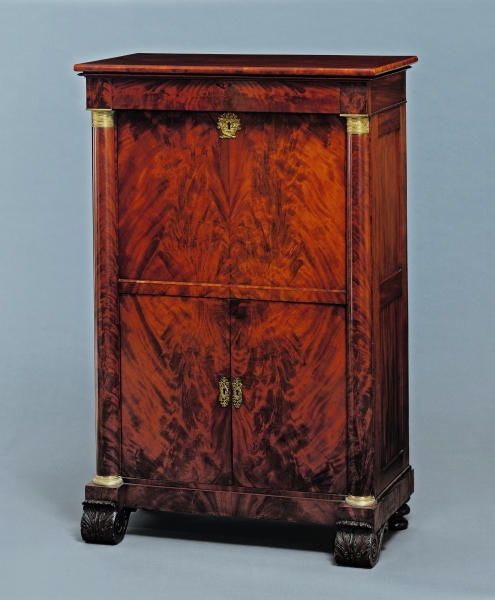
FIG. 17. Secrétaire à abattant, attributed to Isaac Vose & Son, Boston, probably 1822. Mahogany, white pine, yellow poplar, chestnut or ash; h 58½, w 37½, d 20¼. Hood Museum of Art; Gift of Mrs. William Dexter (F.965.90.11).
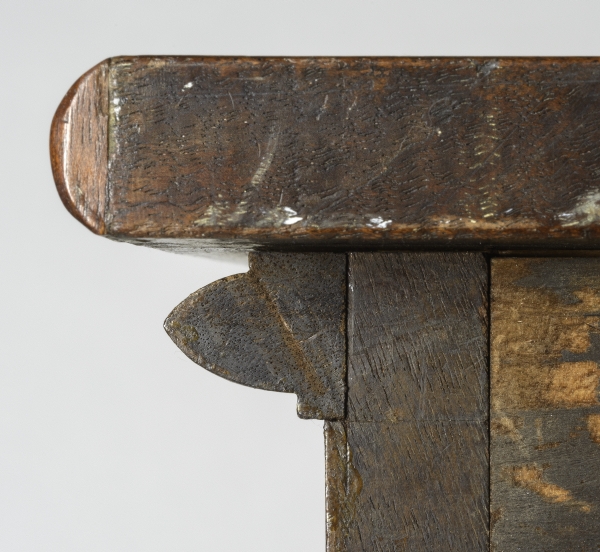
FIG. 18. Rear corner of dressing bureau, showing Grecian ovolo molding (see fig. 14 for another detail of this bureau). Winterthur Museum; Museum purchase in honor of Wendy Cooper with funds drawn from the Wendy Cooper Gift Fund and the Centenary Fund (2015.0005). The profile of the molding matches that on the secrétaire à abattant in fig. 17. The Vose shop and several other Boston cabinetmakers favored this distinctive shape.
In Boston, Grecian dressing bureaus and chests of drawers were called “French.” This term distinguished them from those of English designers and cabinetmakers, who preferred Regency-style case pieces with bowed fronts and turned legs that elevated the cases off the ground. Most Bostonians preferred Regency-style case furniture for bedrooms, but some of the wealthiest and more style-conscious wanted the Grecian, or “French,” forms. These typically have an overhanging frieze drawer at the top, three recessed drawers below flanked by free-standing or engaged columns, with cases raised on a thick base plinth with compressed ball feet. La Mésangère’s publications were replete with handsome designs for this chest form, such as plate 328 titled “Commode en acajou flambé” (chest in flame mahogany). Seymour surely saw these designs but took them a step further with his virtuoso veneering talents.133
A stylish “French” dressing bureau stamped with Vose & Son’s label (fig. 19) is a key to the study of the firm’s products. Conforming to the highest standards of workmanship, it serves as an important document that allows other unmarked case pieces to be attributed to the shop with great accuracy. The drawers below the frieze have long horizontal branch veneers from the same flitch, with the plumes oriented left, right, and left in descending order, an arrangement that typifies Seymour’s veneer work.
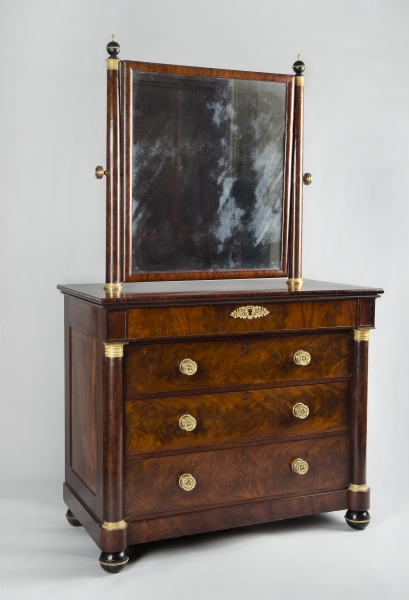
FIG. 19. Dressing bureau, Isaac Vose & Son, Boston, 1820–25. Mahogany, probably ebonized maple, white pine, yellow poplar, ash; h 73¼, w 43¼, d 23¼. Private collection. Photo, Laura Wulf. The stenciled label on this dressing bureau matches that in fig. 14.
The labeled dressing bureau also employs another veneering feature that is unique to the Vose shop and to Seymour’s craftsmanship. Drawer blades and fascia behind the columns are faced with long expanses of tightly figured curly mahogany veneers, seen also on fillet moldings that outline recesses on pilasters, aprons, and stiles. Seymour clearly loved this effect, which added further texture and visual interest to his work beginning about 1805. No other Boston shop appears to have used such perfectly consistent curly mahogany veneer for contrasting texture. Its use highlights the effort and expense the Vose shop expended to please its discriminating customers.134
One of the most striking features of the labeled dressing table (see fig. 15) and Ticknor’s secrétaire (see fig. 17) is the keen perfection of the drawer construction, a hallmark of work from the Vose firm. Based on his French training, precise workmanship, and distinctive florid handwriting script, French immigrant William Piquot was likely the journeyman who made and inscribed these remarkable drawers.135 Piquot apparently had become a drawer-making specialist for the firm by at least 1817–18, as seen on a recently discovered secrétaire à abattant attributed to Vose & Coates, with similarly inscribed drawers.136
The drawer fronts and sides were made of cabinet-grade mahogany, with backs and bottoms of clear “Bay” (Honduras) mahogany. The dovetails are extremely fine, laid out with perfect scribe lines, without visible gaps or saw kerfs. The drawer backs are slightly lower than the drawer sides, and the top rear corners of the drawer sides are perfectly beveled, as are the vertical rear corners of the drawers. Three or five evenly spaced tiny cut sprigs secure the drawer bottoms to the backs. Inside the drawers, mahogany quarter-round moldings often line the lower corners, where the drawer sides meet the bottoms, as seen on the labeled dressing table above. The interior drawers are inscribed on the outside of the drawer backs (figs. 20, 21) with unmistakably florid Ls (left) and Rs (right). These remarkable drawers with their distinctive marks are seen repeatedly on work by Isaac Vose & Son, separating it from all other cabinetwork done in Boston.
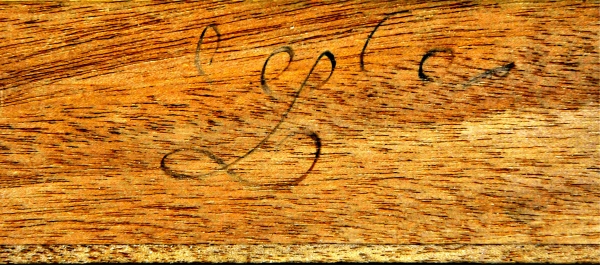
FIG. 20. William Piquot’s marking system, as seen on the secrétaire à abattant in fig. 17.
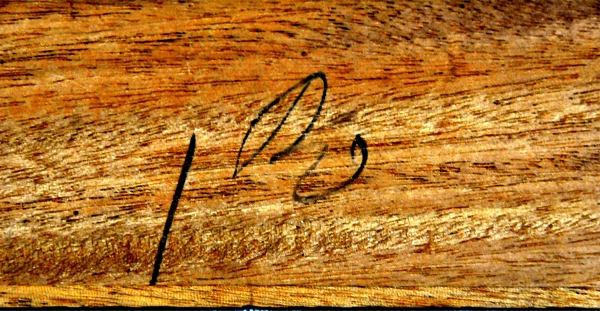
FIG. 21. William Piquot’s marking system, as seen on the secrétaire à abattant in fig. 17.
Some of the furniture made by Isaac Vose & Son for Stephen and Elizabeth Salisbury of Worcester is documented by a letter to Elizabeth from her niece Abigail (Breese) Salisbury.137 In the letter, dated July 28, 1820, Abigail mentions a side table, a pair of card tables, a set of chairs, and a pair of sofas just made by the Vose shop that she had recently inspected there for her aunt. Of these pieces, the card tables and chairs can be identified.138 Distinctive design and construction features of the Salisburys’ card tables (fig. 22), along with a wine cooler that also descended in the family (fig. 23), allow a group of related pieces to be confidently attributed to Isaac Vose & Son.139 These related examples include a sideboard and a sofa table; another pair of card tables; and a side table seen in a photograph (see fig. 9) taken in the 1880s of Nathan Appleton’s dining room.140
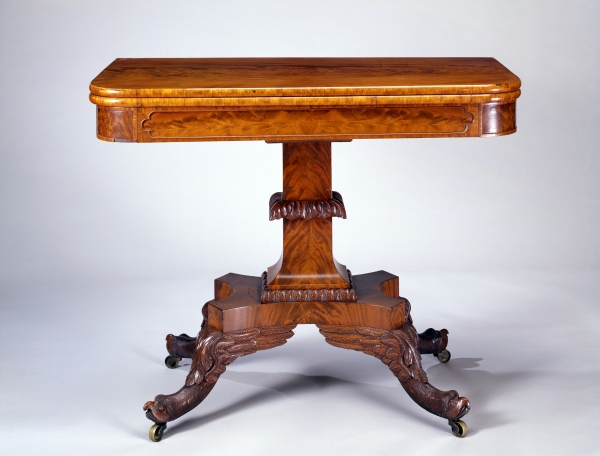
FIG. 22. Grecian card table, attributed to Isaac Vose & Son, with Thomas Wightman, carver, Boston, ca. 1820. Mahogany, Honduras mahogany, Spanish cedar, ash; h 30, w 36¾, d closed 18. Worcester Art Museum; Bequest of Stephen Salisbury III (1917.177).
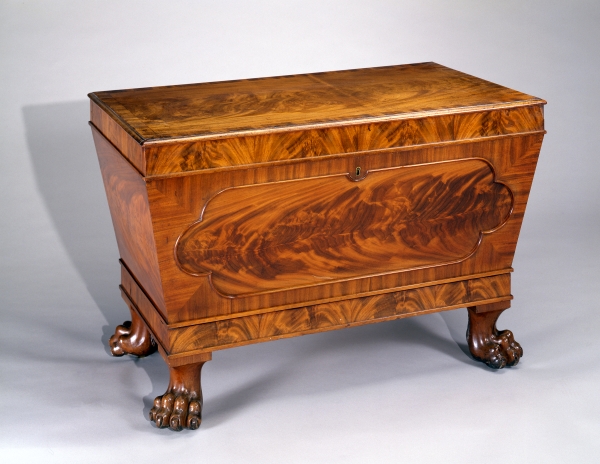
FIG. 23. Grecian wine cooler, attributed to Isaac Vose & Son, Boston, with Thomas Wightman, carver, ca. 1820. Mahogany, ash; h 23¼, w 34¾, d 20¾. Worcester Art Museum; Gift of Stephen Salisbury III (1899.18).
The sarcophagus-shaped wine cooler has four distinctive features: a central recess on the front panel filled with dramatic branch mahogany veneers; a beaded frame around the recess in an elongated quatrefoil shape; a crossbanded and mitered frame of stripe-grained mahogany around the beaded recess; and carved “furry” hocks on the backs of the paw feet. The first feature is employed on a pair of pier tables that Seymour provided to Peter Chardon Brooks in 1816.141 The crossbanded mitered frames (although not seen on Brooks’s pier tables) are one of Seymour’s favorite devices. All these features are present on the Salisbury card tables. The carved paw feet with furry hocks on the wine cooler are closely associated with the work of Thomas Wightman.
Isaac Vose, Thomas Seymour, and Thomas Wightman were a formidable team. One of the early masterworks from this collaboration is a Grecian sideboard that presents a fully formed expression of a creative Boston aesthetic that built on a vocabulary of ancient design (fig. 24). It can be accurately attributed to the Isaac Vose & Son shop based on the idiosyncratic treatment of both the facade of the wine cooler and the aprons of the card tables mentioned in the Salisbury letter. This sideboard, or one of similar design, may be what Abigail Salisbury called a “side table” in her letter. The sideboard shares with those pieces the elongated quatrefoil-shaped and beaded recesses filled with branch veneers, each framed by mitered stripe-figured mahogany veneers. Wedged through-tenons, moldings set into grooves, use of ash as a secondary wood, and the drawer construction are all typical of Seymour’s preferences, adding further credence to the attribution.142
FIG. 24. Grecian sideboard, attributed to Isaac Vose & Son, Boston, with Thomas Wightman, carver, Boston, 1820–22. Mahogany, Honduras mahogany, white pine, ash, birch; h 45⅞, w 73⅞, d 23⅞. Private collection. Photo, Laura Wulf.
The sideboard is a fine example of Seymour’s artistic use of highly figured veneers. He employed plumes of branch veneer in the recesses of the narrow facade to accentuate the horizontal severity of the top and book-matched them in the central drawer to draw the eye toward the center. The small elongated quatrefoil panels at the ends of the frieze are rotated vertically to contain the powerful horizontal flow. The legs convey a sense of strength and power through the downward movement of the vertical branch veneers, while their tapering form and the spring of the paw feet relieve the heaviness of the case above.
Wightman’s carving on the legs provides a brilliant counterbalance to the broad expanses of flat branch veneer elsewhere. At the top of the legs he employs the meme of the Ionic scroll. His bell-shaped fringe of acanthus leaves below is deeply undercut and alive with subtle naturalistic movement, affirming his major talent.
A sideboard of about 1815 attributed to Thomas Seymour (fig. 25) represents an early attempt in the Grecian style, not altogether successful, that provides a fine introduction to Wightman’s superlative carving.143 The semicircular tablets above the legs show a whorl of curving acanthus leaves in high relief, alternating with waterleaves in low relief emanating from a central bud (fig. 26). The larger leaves, drawn in crisp high relief, undulate in naturalistic S curves. Each leaflet moves in a slightly different direction. The interspersed and recessed waterleaves, carved in low relief with sharp central creases, curve gently in the prevailing direction of the flanking leaves. This subtle natural variation lends drama and cohesion to the composition. Although no sketches for Wightman’s carving are known, his carefully thought-out and well-integrated designs are clear proof of a talented draftsman.144 The exact pattern for Wightman’s S-shaped carved acanthus leaves was first published in 1806 by Boston architect Asher Benjamin in his American Builder’s Companion (fig. 27). The engraver of Benjamin’s plate was none other than Thomas Wightman Jr., who had also trained in London before immigrating to Boston in 1800 (see also fig. 3).145
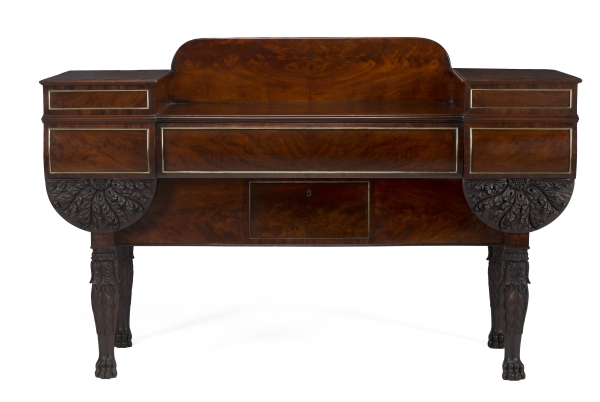
FIG. 25. Grecian sideboard, attributed to Thomas Seymour, with Thomas Wightman, carver, Boston, 1814–17. Mahogany, Honduras mahogany, white pine, ash; h 50½, w 79¼, d 25⅞. Historic New England; Gift of Miss Frances R. Morse (1929.362).
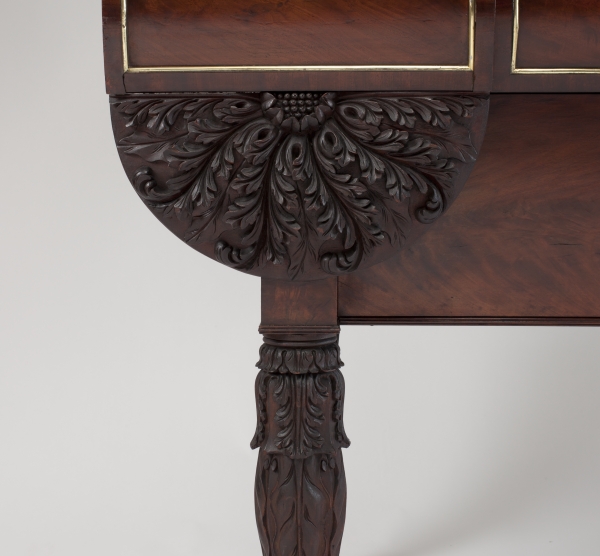
FIG. 26. Carving by Thomas Wightman on the Grecian sideboard in fig. 25.
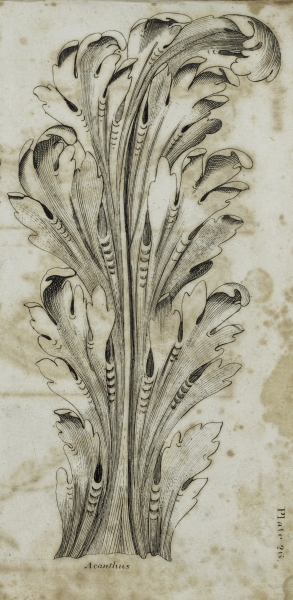
FIG. 27. “Acanthus leaf,” drawn by Daniel Reynard, engraved by Thomas Wightman Jr. From Asher Benjamin, The American Builder’s Companion; or, A New System of Architecture (Boston, 1806), pl. 26 (detail). Winterthur Library; Printed Books and Periodicals Collection.
Fashionable furniture imported from England in the 1810s and 1820s directly influenced design in Boston. Unfortunately, most of this expensive furniture has long since lost its association with prominent Boston families, but at least one exception is known. Nathan Appleton owned a stylish English rosewood Davenport desk with elaborate marquetry inlays (fig. 28).146 Similarities in design and construction between this English desk and a Boston-made version attributed to Isaac Vose & Son are striking.147 Vose and/or Seymour likely saw their customer’s English desk and used it as the model (fig. 29).
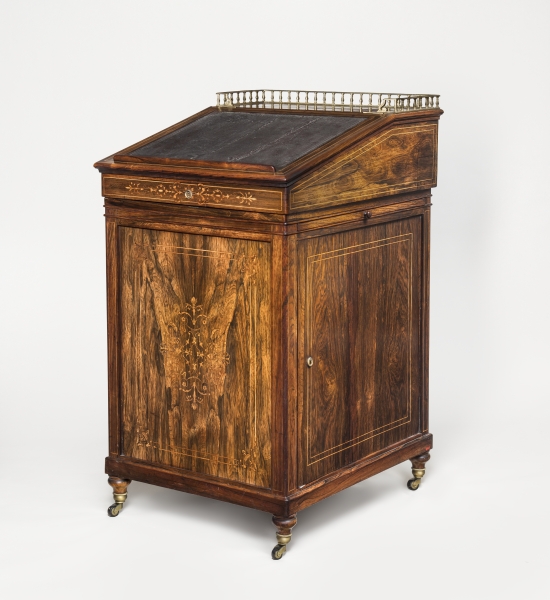
FIG. 28. Davenport desk, probably London, 1815–20. Rosewood, satinwood, ebony, lime, oak, ash, lignum vitae, lightwood marquetry inlay; h 34, w 19¼, d 22¾. National Park Service, Longfellow House-Washington’s Headquarters National Historic Site (LONG 4144). Photo, Gavin Ashworth. This English desk belonged to Nathan Appleton (1779–1861) and may have served as a model for Boston versions of the form as seen in fig. 29.
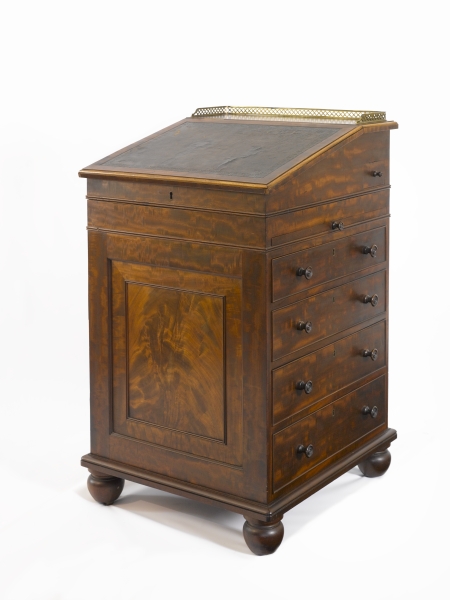
FIG. 29. Davenport desk, attributed to Isaac Vose & Son, Boston, 1820–25. Mahogany, Honduras mahogany, ebony, white pine; h 36¼, w 20¼, d 22¼. Private collection. Photo, Jeffrey Allen.
Other imported furniture is pictured in a silhouette by French artist Augustin Edouart that depicts the family of Daniel P. Parker in their home at 40 Beacon Street (fig. 30). The interior appears to be filled with stylish English furniture. Parker and his wife (Mary Weeks) are seated at a Grecian center table in front of the fireplace, flanked by two of their children.148 The table is likely English, with its apron panels of thick reeding. A remarkably similar Boston table with unknown provenance was likely modeled after this table and can be attributed to Isaac Vose & Son (fig. 31).149 Both share the overall Grecian form, circular aprons with three long rectangular panels interrupted by the stiles of the legs, and recessed panels above the legs. They also have distinctive straight vertical rear edges on the legs, carved oval scrolls on side faces of the legs with half-anthemion tendrils unfolding underneath, and cuffed paw feet. However, the Vose & Son version eliminated the plinth entirely and adapted the apron design by leaving off the thick reeding of the English version.
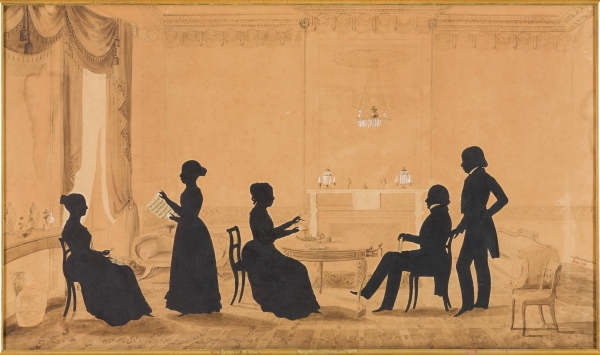
FIG. 30. The Daniel P. Parker Family in the Front Parlor of their Home at 40 Beacon Street, Boston, Massachusetts, Augustin Edouart (1789–1861), Boston, 1842. Free-hand cut black paper detailed with pencil drawing, mounted on a ground of sepia wash and Chinese white; h 181/16, w 30¼. Private collection. Photo, R. H. Hensleigh.
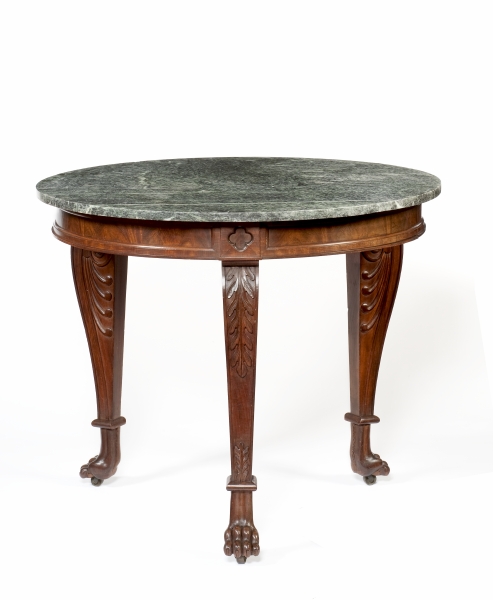
FIG. 31. Grecian center table, attributed to Isaac Vose & Son, Boston, 1819–22. Mahogany, ash, white pine; h 29¾, Diam 36. Private collection. Photo, David Bohl.
The carving on the Boston center table is very fine and shows the hallmarks of Wightman’s style, while veneering and quatrefoil moldings in the apron recesses reveal the hand of Seymour.150 This table is a bold and sophisticated statement of the Grecian style in Boston, one that was clearly influenced by an imported English example.
An English rosewood card table with a peculiarly flared rectangular pillar and distinctive carved eagle-head feet (probably imported by Vose or one of his clients) may have provided the design inspiration for a group of tables, including the pair of card tables ordered by Stephen and Elizabeth Salisbury (see fig. 22).151 Perhaps the best example of this group is a sofa table that clearly was crafted in the Vose & Son shop (fig. 32).152 Although its provenance is unknown, the perfect workmanship of the drawers, presumably by William Piquot, the excellent quality of the mounts and casters, the refined selection and placement of veneers, and the use of fine mahogany for most secondary elements are all consistent with the best work from this source. The table also incorporates construction features unique to Isaac Vose & Son. These include a heavy arched and precisely beveled mahogany medial rail at the top of the pillar. This is notched across the upper surface to house the wide T head of the threaded central steel bolt that secures the base below. Shallow rabbets cut into the plinth and medial rail, which capture the ends of the pillar to prevent pivoting, are also distinctive. Strengthening the link to the Vose shop, the pattern of the die-rolled brass molding at the base of the pillar was copied exactly in carved wood by Wightman on the Salisbury card tables.
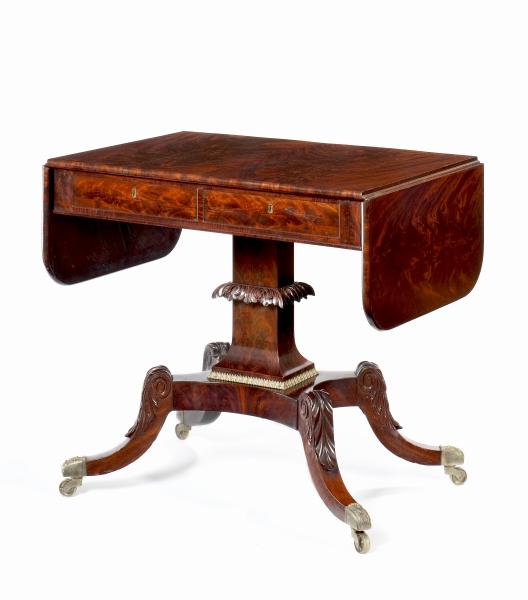
FIG. 32. Grecian sofa table, attributed to Isaac Vose & Son, with Thomas Wightman, carver, Boston, 1819–25. Mahogany, white pine; h 28⅞, w open 52¾, d 21¼. Private collection. Photo, David Bohl.
All the tables with flared rectangular pillars share leafage-carved collars surrounding the column. Each collar is made from a single piece of mahogany with a large rectangular cut-out in the center, allowing it to slide into place over the top of the pillar. These carvings on the collar and legs of this sofa table embody the brilliance of Wightman’s work. These feature directional movement of the deeply undercut leaves flowing over the edge of the collar and lifelike waterleaves that gracefully roll over the oval spirals at the tops of the legs. Although this form is unfamiliar to most scholars and collectors, it is a superlative example that blends the Grecian and Regency styles in a way known only in Boston in the early 1820s.
English design books also provided Boston cabinetmakers with a cornucopia of inspiration. Earlier in his career, Seymour and his father owned a copy of The Cabinet-Maker and Upholsterer’s Drawing-Book by Thomas Sheraton.153 Based on numerous examples of his later Regency furniture adapted directly from designs in Sheraton’s Cabinet Dictionary of 1803, Seymour almost certainly owned a copy of that publication as well.154 Publisher Rudolph Ackermann was the greatest chronicler of the latest styles seen in London during this period. His monthly periodical The Repository of Arts, Literature, Commerce, Manufactures, Fashion and Politics, published between 1809 and 1829 in London, was highly influential in Boston. At least two or possibly three of the designs in the Repository were clearly adapted by the Vose shop for its own local versions.155
The English designer Thomas King also had an impact in Salem and Boston. Although he is best known today for the 1829 publication The Modern Style of Cabinet Work Exemplified, his earlier publications were circulated starting at least in 1823, sometimes issued as loose folio plates, or as published volumes of plates. Seymour and Vose copied line for line one of King’s designs for a magnificent “Pier Slab” in the ornate Grecian style, creating a tour de force of bold Grecian scrolls that incorporated Wightman’s best carving.156 The design was probably included in one of his earlier editions (as yet unlocated) that predated the closing of the Vose shop. Many of King’s patterns were hugely popular in the second half of the 1820s and later, when George Archbald was prominent in the cabinetmaking trade in Boston.
Grecian pedestal card and center tables, with their tapered pylon columns inspired by Egyptian architecture and flat plinth bases, had been fashionable in England through the 1810s. Imported examples as well as contemporary published designs undoubtedly provided the inspiration for this ubiquitous form in Boston. In the early nineteenth century, the term Grecian was used to describe any design or architectural motif that originated from ancient Greece, Rome, Egypt, indeed anywhere in the Mediterranean or western Asia. Boston cabinetmakers assembled bits and pieces from ancient and contemporary designs to form a synthesis never imagined in the classical world, calling it “Grecian.”
On August 17, 1824, Peter Chardon Brooks recorded in his waste book the purchase of a large Grecian table “4½ by 5” for $26 from Isaac Vose & Son.157 It is almost certainly the impressive tilt-top pedestal center table now at the Adams National Historic Site (fig. 33).158 Brooks was an early adopter of the Grecian style, recording the purchase of a pair of “Grecian card tables” from Seymour in 1816 (see fig. 9).159 The form had changed little by the time he bought this Grecian center table eight years later. Pedestal tables of this type were popular in Boston, and this example is representative of a number of similar tables that descended from prominent families and can be attributed to Vose & Son.160
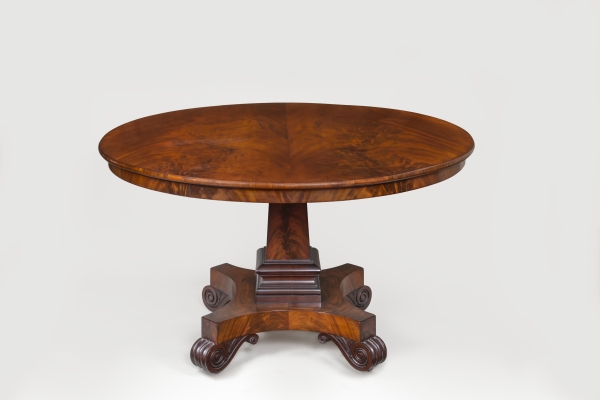
FIG. 33. Grecian center table, attributed to Isaac Vose & Son, with Thomas Wightman, carver, Boston, ca. 1824. Mahogany, Honduras mahogany, ash; h 28½, Diam 47⅞. National Park Service, Adams National Historical Park (ADAM 130). Photo, Gavin Ashworth.
Brooks’s center table reflects Isaac Vose & Son practices for this period in its exceptional construction and veneering.161 The four elaborate horizontal moldings at the base of the pylon are shaped from single pieces of vertical-grain mahogany, mitered at the corners, exactly like the pair of card tables Brooks bought from Seymour in 1816. This cross-grain work is a more difficult and labor-intensive method of cutting moldings, but it adds a degree of subtlety and visual interest that typifies the work from this shop. The horizontal top of the plinth is veneered with four separate pieces of branch mahogany, with each plume radiating diagonally over each foot, a signature feature of Seymour’s work.
Pedestal card and center tables from the Vose shop have recognizable construction features that differentiate them from the work of his many competitors. One of the firm’s most spectacular in the Grecian style is a card table of solid and veneered satinwood (fig. 34) that descended in the Lyman family.162 It is built exactly as the only labeled Grecian card table that is known from the Isaac Vose & Son shop.163 One such feature is the use of a heavy mahogany rail that joins with double tenons into the front and rear rails, parallel to the medial rail. It serves as a sturdy anchor for the swivel bolt that allows the top to turn. A second feature is the mitered terminations of the crossbanding surrounding the scrolled ends, which are cut at 135-degree and 85-degree angles, rather than 45-degree angles. A third is the placement of book-matched curly satinwood veneers set at opposing diagonal angles, copying typical English practice. Vose again relied on his role as an importer of tropical woods to procure enough of the rare “bee’s wing” or mottled satinwood for the top, apron, and pylon. This table is a superb example of the highest level of craftsmanship, wood, and veneer selection, making it one of the most expensive card tables made in Boston in this period.164
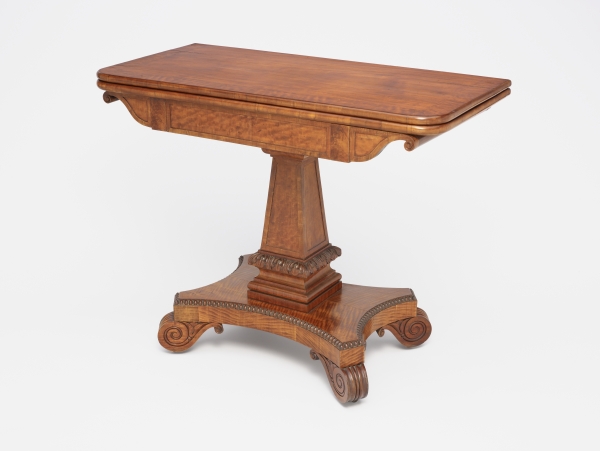
FIG. 34. Grecian card table, attributed to Isaac Vose & Son, with Thomas Wightman, carver, Boston, 1819–23. Satinwood, mahogany; h 28⅛, w 36⅝, d 18. Art Institute of Chicago; Restricted gift of Harry A. Root in memory of Curtis C. Palmer (2012.125).
Chairs and Sofas
According to the 1818–25 tax records, Isaac Vose rented a “chair store” from William Dall in a building adjacent to his main shop.165 Fancy chairmaker and painter Joshua Holden rented lodgings and a workshop from Vose from 1812 through the 1820s, during which time he most likely consigned fancy painted chairs to Vose’s store. However, Holden was apparently only making and painting a line of fancy chairs, not formal mahogany chairs, for Vose.166
Tax records also show that in the five years after Thomas Seymour arrived to supervise the shop, eight journeymen chairmakers were housed for varying periods in Vose’s properties.167 Most probably worked for Vose, though some are listed as living in Holden’s tenement (which he rented from Vose) and were probably employed directly by him. Some were British immigrants. One of Isaac Vose & Son’s many advertisements stated that the firm had “on hand a large assortment of . . . Mahogany and Rose Wood chairs.”168 Apart from a surviving set of middling-quality chairs of Grecian design from the Salisburys’ 1820 order, however, few mahogany chairs from Vose’s shop have been documented.169
However, the recent discovery of a pair of inscribed armchairs from the Isaac Vose & Son shop provides a key for identifying several other sets of chairs (fig. 35). Both chairs are inscribed in ink on open cross-braces under the seat: “Hedges / upholsterer / Boston / 1820.”170 Thomas Hedges (act. at least 1818–24), a British immigrant upholsterer, worked as limited partner to Isaac Vose from 1818 until Vose died in 1823.171 Because no original upholstery survives on the pair, the seats tell us little about Hedges’s work, but by virtue of the date, the inscriptions confirm the chairs as products of this shop. Their construction is very English and closely follows several features found on chairs from a decade earlier that are attributed to Seymour.172
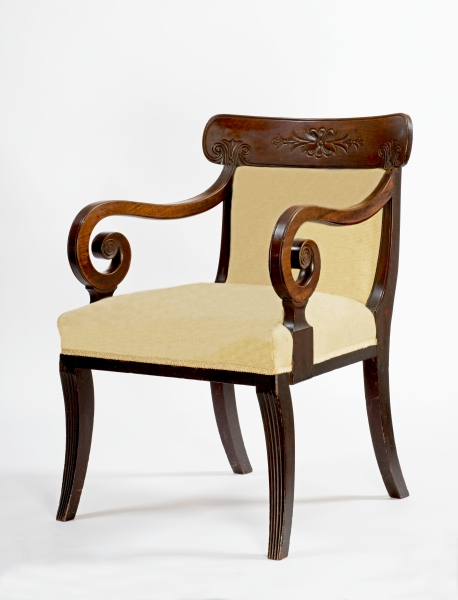
FIG. 35. Grecian armchair, attributed to Isaac Vose & Son, with Thomas Wightman, carver, and Thomas Hedges, upholsterer, Boston, 1820. Mahogany, birch, yellow poplar, white pine; h 32⅜, w 21½, d 23. Private collection. Photo, David Bohl. One of the braces beneath the seat is inscribed “Hedges / upholsterer / Boston / 1820.”
The deeply curved tablet-form crests on the Hedges chairs are unusual because they are embellished with intaglio carving, that is, the carving is not in relief but below the surface. Similar carving is found on English Regency chairs of the period. The perfection of the botanical forms, careful drawing, crisp outlining cuts, and steadiness of line are all hallmarks of Thomas Wightman’s carving. The central cruciform flower and sprays of bellflowers are motifs encountered regularly in his work.173
Two other sets of chairs can be firmly attributed to the Vose shop on the strength of the armchairs inscribed by Hedges. One set is represented by a single armchair that is almost certainly part of the larger set that probably belonged to Nathan Appleton (fig. 36). A number of chairs from this set are pictured in a series of 1880s photographs of the dining room of “Sharksmouth,” the summer home of Nathan Appleton’s daughter Harriot Sumner (Appleton) Curtis in Manchester, Massachusetts.174 A second set is represented by four side chairs that follow the Hedges chairs almost exactly in form and construction but have more squared, rectangular crests, reeding on the stiles, and pairs of carved lotus blossoms between the stay rails in the backs.175
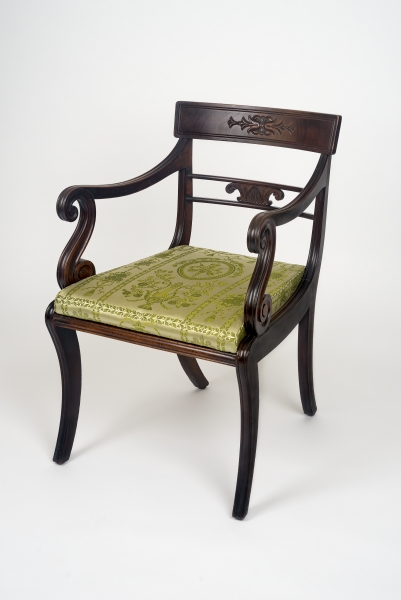
FIG. 36. Grecian armchair, attributed to Isaac Vose & Son, with Thomas Wightman, carver, and Thomas Hedges, upholsterer, Boston, 1820–23. Mahogany, birch, original underupholstery; h 33⅜, w 21⅞, d 24½. Private collection. Photo, Laura Wulf.
The underupholstery on the single armchair from Sharksmouth is original and survives surprisingly intact. This upholstery is probably the work of Thomas Hedges before he dissolved his partnership with Vose. It is an excellent example of the new fashion for Regency and Grecian chair seats in Boston, displaying sharp and boxy stitched corners on the rear and side edges, with a large-diameter edge rolling down dramatically at the front. Numerous French and English design books show variations of this idea. Hedges and other British immigrant journeymen upholsterers working in Boston, including William Lemon and William Neale, brought with them the knowledge and the skills to make these new fashions possible.176
A recently discovered sofa reveals that some of the most innovative work from the Vose shop was lavished on seating furniture. The Reverend Francis Parkman (1788–1852) inherited some of the wealth that his father Samuel made as a merchant and developer of Boston’s West End (fig. 37). In 1822, Francis married Caroline Hall (1794–1871), a niece of Peter Chardon Brooks, and apparently began purchasing a group of furniture from Isaac Vose & Son. His purchases likely included a Grecian sofa (fig. 38) that is inscribed “Stufd by Otis Packard at / Isaac Voses Boston / August 24th / 1823 OP.” It retains its original underupholstery on the back and arms, as well as its box-stitched horsehair mattress. It also has remnants of the original peach-colored silk show cover with green trim tape on the padded arms, evidence of its luxurious first treatment that guided its recent reupholstery.177 The inscription documents not only a new form to the Vose shop but also a previously unknown journeyman upholsterer who was also Vose’s nephew.178 Otis Packard (1804–1870) probably already worked either directly for Vose or for Hedges. With Hedges’s departure from the Vose & Son shop just days after the elder Vose’s death, Packard stayed on and completed the sofa upholstery.179
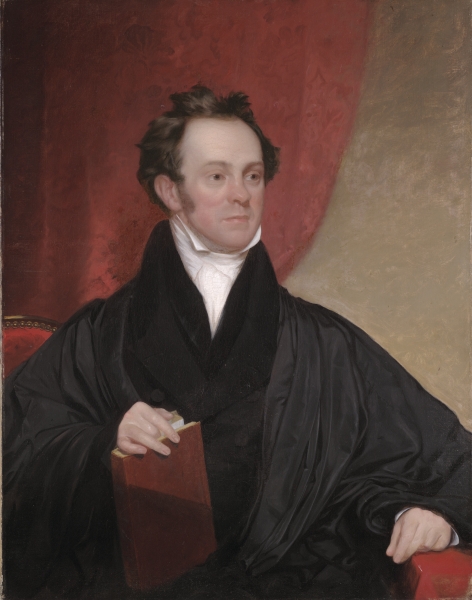
FIG. 37. Rev. Francis Parkman (1788–1852), Chester Harding (1792–1866), Boston, ca. 1832. Oil on canvas; h 36, w 28⅛. Harvard University Portrait Collection; Bequest of Eliza W. S. Parkman, 1906 (H132).
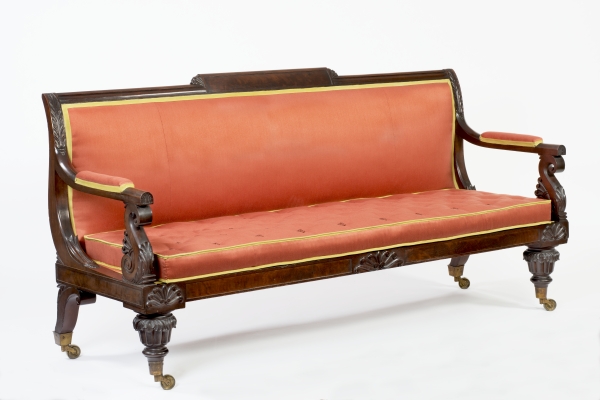
FIG. 38. Grecian sofa, Vose & Son, with Thomas Wightman, carver, and Otis Packard (1804–1870), upholsterer, Boston, ca. 1823. Mahogany, cherry, maple, birch, original underupholstery; h 38⅛, w 76, d 24. Colonial Society of Massachusetts; Gift of the grandchildren of Francis Parkman, Jr.: Mrs. John Forbes Perkins, Mrs. Alexander S. Neilson, Mrs. Daniel Sargent, and Mr. John T. Coolidge (14.400). Photo, David Bohl. A vertical stile in the back of the sofa is inscribed “Stufd by Otis Packard at / Isaac Voses Boston / August 24th / 1823 OP.”
The design of the sofa is an original assemblage of different classical elements from French and English furniture design books of the period, but it is not modeled after any particular one. Versions of the straight horizontal arms with abruptly terminated and carved ends, the oversize “stump” legs with large reeds in front, and the subtle S curve of the back can be seen in designs by La Mésangère, Sheraton, Ackermann, and James Barron.180 As on the armchair in figure 36, the dramatic S-curved arm supports are tilted forward on their axis and beautifully carved with leaves, palmettes, and anthemia. These elements illustrate the spirit of experimentation and creativity that distinguishes Boston classical furniture, with the collaboration of Vose, Seymour, and Wightman in the leadership roles.
A Grecian settee attributed to Thomas Seymour, circa 1815, in a private collection adapts a design in Thomas Sheraton’s Cabinet Dictionary. It has many construction features that reveal Seymour’s hand.181 At least eight sets of Grecian chairs, all similar in profile, can now be attributed to the Vose shop, with Seymour as foreman, based on the joinery of this settee. Each set is designed in a standard Grecian format with slight variations in the stay-rail shapes, patterns of reeding, and optional paw feet. More important, the tablet crests and stay rails on these eight sets all have different patterns of Wightman’s virtuoso carving, giving us an impressive sampling of the vocabulary in his designs. One of the most beautiful interpretations of this group has a leafy acanthus patera centered by cruciform blossoms on the crest rail tablets (fig. 39).182
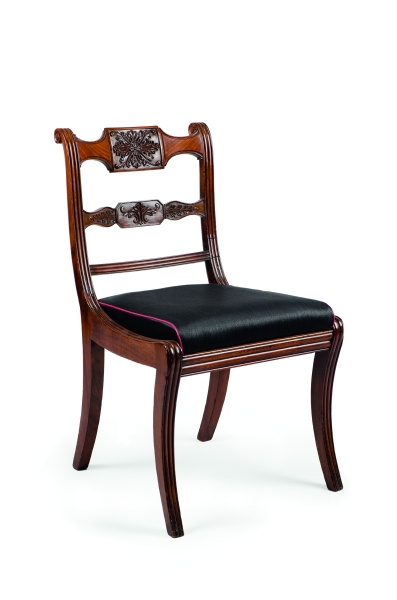
FIG. 39. Grecian side chair, attributed to Isaac Vose & Son, with Thomas Wightman, carver, Boston, 1820–25. Mahogany, birch, maple, ash; h 33¼, w 19⅜, d 20¾. Private collection. Photo, Laura Wulf.
Several of the eight sets of chairs retain their original serpentine-shaped glue blocks that are each secured to adjoining rails with two screws in the seat rail corners. The use of these distinctive blocks was apparently introduced to Boston by Thomas Seymour about 1810–12. This new style supplanted the open braces and solid triangular blocks familiar on most of his earlier chairs. The presence of similar serpentine corner blocks, when original, adds another layer of confirmation to the attribution of the group of chair sets to the shop of Isaac Vose & Son.
The Lavish Taste of David Sears
The finest known work of Isaac Vose & Son was made for David Sears Jr. (1787–1871). One of the wealthiest men in Boston, Sears lived two doors below Daniel P. Parker and Nathan Appleton on Beacon Street, and just above Samuel Appleton. In 1817, he inherited from his father what was then reported to be the largest estate in Boston history. Three extraordinary pieces of furniture owned by Sears—a center table, a secrétaire à abattant, and a linen press—demonstrate that the firm was catering to the highest and most demanding elements of Boston society. All three represent the pinnacle of design and craftsmanship in this period. They share rich cast-brass mounts not seen on any other furniture in Boston, and their presence suggests that Vose made a special order from his suppliers in Birmingham and Paris to outfit the extraordinary suite.183
Sears’s Grecian rosewood center table with imported Italian specimen marble top combines a highly simplified design with lavish materials to achieve the height of understated elegance (fig. 40).184 The base and foot design borrows the scrolls from the top of Ionic capitals and pares them down to their basic form, with only the surface-mounted beaded brass molding to articulate the order’s spiral. The smooth central pillar is turned with entasis, the ancient solution devised to compensate for the optical illusion of concavity created by straight-sided columns. Even the imported marble top echoes Greek and Roman mosaic decoration. The secondary wood is first-quality mahogany throughout, meticulously covered with rosewood veneer of subtle grain.185 With the Vose firm at the height of its creative powers, the introduction of this table form was seminal. Tables with similar Ionic scroll bases became ubiquitous in Boston a decade later.
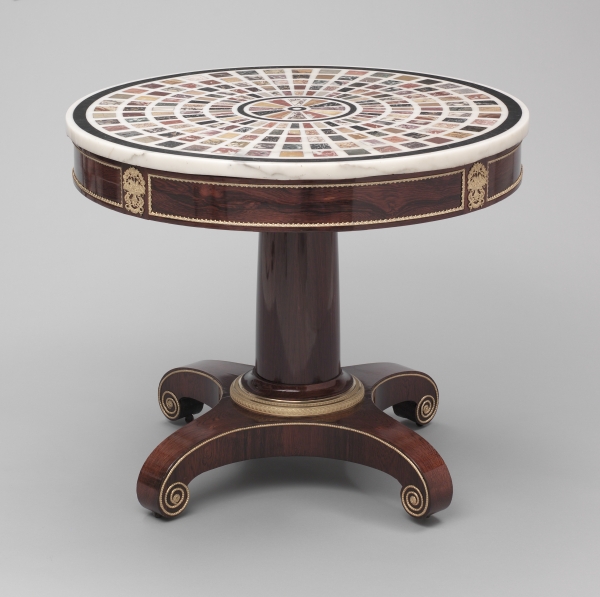
FIG. 40. Grecian center table with specimen marble top, attributed to Isaac Vose & Son, Boston, 1822–25. Rosewood, mahogany; h 29¾, Diam 36. Detroit Institute of Arts; Museum Purchase, Robert H. Tannahill Foundation Fund, Associates of the American Wing, The Boos Family in memory of Frank H. Boos, Mrs. Stanley P. Sax, Vivian Day and John Stroh III, Mrs. Edward J. Tutag, Dr. Theodore and Diana Golden, Anonymous Donor, Rick and Sheryl Bone, Amanda Van Dusen and Curtis Blessing, Winnifred Poland Pierce, Mrs. Judith Goodnow Prus and Dr. A. Michael Prus and other anonymous donors (2006.88.A).
An ambitious secrétaire à abattant that also descended from David Sears can be attributed to Isaac Vose & Son based on numerous construction features (fig. 41).186 Obviously made to Sears’s order, the facade design deviates from the normal secrétaire format by the addition of large compartments flanking the central section, which are accessed by doors on the sides. To integrate this extra width, Vose and Seymour borrowed from La Mésangère a design for a bed that employs a pair of columns at each end to create visual interest and relieve the appearance of great mass.187 Seymour selected exotic grain patterns to compose a clever design that harmonizes the complicated elements of this unique form.
Another masterpiece from the Isaac Vose & Son shop is a French linen press of impressive scale (fig. 42). It is one of the most elegant and beautifully made objects encountered during this project, and it was also purchased from a Sears descendant. Like the secrétaire, this press is built on an expanded scale. It combines the functions of a chest of drawers at the lower center, with sliding linen trays in the upper and side cases. Seymour’s hand is visible in the skillful manipulation of the spectacular branch mahogany veneers, impeccable construction details, and unique profiles of the sides of the linen trays. Their elegant shapes represent sections of classical cavetto moldings, one of Seymour’s favorite motifs.188
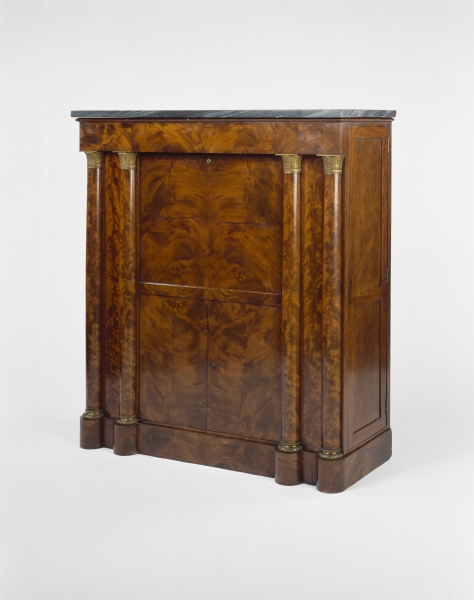
FIG. 41. Secrétaire à abattant, attributed to Isaac Vose & Son, Boston, 1820–25. Mahogany, Honduras mahogany, yellow poplar, white pine; h 57¾, w 52⅜, d 19. Art Institute of Chicago; Gift of the Antiquarian Society through the Lena T. Gilbert Fund (1983.30).
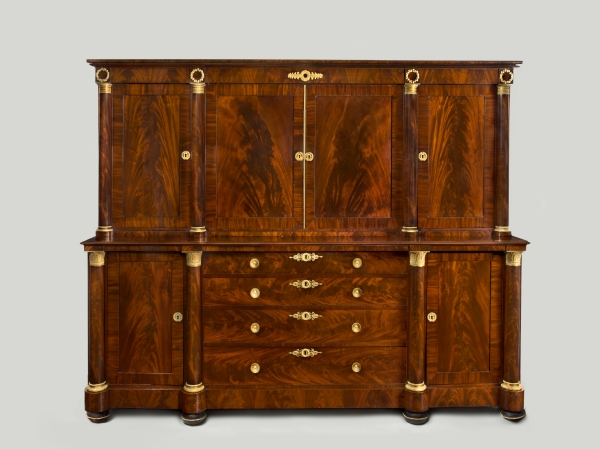
FIG. 42. Grecian linen press, attributed to Isaac Vose & Son, Boston, 1820–25. Mahogany, probably ebonized maple, white pine, yellow poplar, ash; h 70¼, w 89¼, d 24¾. Private collection. Photo, Gavin Ashworth.
THE VOSE SHOP CLOSES, 1825
After thirty-four years of success while building his team of outstanding and largely immigrant craftsmen, Isaac Vose died of “brain fever” on May 12, 1823, at age fifty-six.189 His son and partner advertised one month later, asking customers for “a continuance of their favors” and stating that he would continue “the Cabinet business, in all its branches.” He also highlighted his large stock of recently imported lamps and looking glasses.190 For the next two years, Isaac Jr. struggled to maintain the complex business he had inherited. By the following spring, perhaps in an attempt to reassure his clientele, he advertised that “Their Cabinet Manufactory is under the direction of Mr. Thomas Seymour.”191
Isaac Vose Jr. and his brother-in-law (and cousin) Charles Bemis (1789–1874) finally announced on January 5, 1825, their intention as executors “to close their Cabinet Business, and confine themselves to importing and selling Lamps.”192 The partners continued in business in Boston until 1831 as Bemis & Vose, importing and retailing London lighting and other luxury furnishings.193 Thomas Emmons and George Archbald, principal competitors of Isaac Vose & Son, dissolved their partnership on March 3, 1825. Emmons announced the same day that he had purchased the cabinetmaking portion of “Isaac Vose & Son,” including the house and shop, after taking out a private mortgage from Vose’s heirs for $10,000.194 Less than two months later, Thomas Emmons died of “pleurisy fever.”195
With the passing of Isaac Vose and Thomas Emmons, the brilliance of the Boston furniture trade lost much of its luster. After 1825, Vose’s stable of skilled artisans dispersed. Thomas Wightman continued carving for other shops but struggled financially.196 He died intestate in Boston in 1827 from “a tumor,” never having owned real estate in the city in which he worked.197 By 1826, Thomas Seymour had moved to the southern end of Washington Street, into or adjacent to a building rented by cabinetmaker William Fisk; he may have worked for a few years there as a journeyman to Fisk or as an independent cabinetmaker. Tax listings in 1829 and later years identify his occupation as “agent.”198 A later historian of the Massachusetts Charitable Mechanic Association noted that Seymour “had charge of Baldwins Mills [as his brother-in-law’s agent] sawing Mahogany veneers &c—the Sawing of Veneers by Circular Saws was introduced at those Mills.”199 The mills were owned by his brother-in-law Aaron Baldwin and, by 1825 or 1826, were located on Northampton Street (later renamed Camden Street) near William Fisk’s shop.200 Like Wightman, Seymour never owned property in Boston. He eventually retired with his wife about 1842 to a Baldwin-family property in rural Lunenburg and died there in 1848.201
Thomas Emmons’s former partner, the Boston-born George Archbald (1790–1870), continued as an independent cabinetmaker and was a successful and widely respected Boston furniture manufacturer at least into the late 1840s. He eventually purchased a portion of Vose’s former premises on Washington and Dover Streets, built several houses there, and worked from a shop there until retiring to his farm in rural Hopkinton, Massachusetts.202
LASTING INFLUENCE
The decade between 1815 and 1825 was a special time when a small group of talented craftsmen and artisans came together to create some of the most finely crafted and startlingly beautiful furniture Boston has ever known. Thomas Seymour was a pioneer who embraced the Regency and Grecian styles with relish after spending a long and fruitful career creating some of the finest neoclassical furniture in America. His talents as designer-craftsman and Isaac Vose’s nose for business and marketing combined perfectly to ride the wave of prosperity in Boston that followed the end of the War of 1812. Vose’s increasing reliance on highly talented immigrant craftsmen such as Thomas Wightman, William Piquot, and Thomas Hedges allowed his firm to offer the latest styles from England and Europe, together with the highest level of craftsmanship. Vose supplied his clientele with the finest selection of woods and veneers available in Boston. He and Seymour also ran a well-organized operation that became perhaps one of the most prolific cabinetmaking shops of the era. The collaboration of these men cemented the tone for Boston classical furniture well after the cabinet shop closed in 1825 and into the 1840s, when rococo-revival styles began to evolve from classical ideas.
APPENDIX
Listed below are the known labeled and documented objects from the several Vose shops that are not illustrated in this essay. The source of the documentation is noted, and, when known, the current location of the object is given, as well as a reference to a published illustration.
- Painted sewing table inscribed in ink “Vose & Coates.”
- Winterthur Museum (1957.0983); see Charles F. Montgomery, American Furniture, The Federal Period (New York: Viking Press, 1966), 462, cat. no. 477.
- Marble-top pier table (the mate to the example in fig. 10) documented by the original bill of sale from Vose, Coates & Company to John Davis Williams, dated October 18, 1818 (Rhode Island School of Design Museum).
- Private collection; see Northeast Auctions, Mar. 14–15, 1992, lot 507.
- Dressing bureau with the stenciled label of Isaac Vose & Son (similar to the one illustrated in fig. 19).
- Winterthur Museum (2015.0005); see Lita Solis-Cohen, “Winterthur Announces Acquisitions,” Maine Antique Digest 43, no. 5 (May 2015): 12A.
- Card table with the stenciled label of Isaac Vose & Son.
- Location unknown; see Charlton Hall, 80th Anniversary Auction, June 6, 2010, lot 750.
- Card table with the stenciled label of Isaac Vose & Son.
- Saint Louis Art Museum (127.1965); see Page Talbott, “Boston Empire Furniture, Part 1,” Antiques 107, no. 5 (May 1975): 883, fig. 7.
- Secrétaire à abattant with the stenciled label of Isaac Vose & Son.
- Smithsonian Institution (S1.71.8); see Talbott, “Boston Empire Furniture, Part 1,” 880, pl. 2.
- Center table with the stenciled label of Isaac Vose & Son.
- Texas governor’s mansion, Austin (F00224); see Nineteenth Century 2, no. 2 (Summer 1977): 25.
- Washstand with the stenciled label of Isaac Vose & Son.
- Private collection; see Page Talbott, “Boston Empire Furniture, Part II,” Antiques 109, no. 5 (May 1976): 1012, fig. 14.
- Set of fourteen dining chairs documented by a letter to Elizabeth Salisbury from her niece Abigail Salisbury, dated July 28, 1820 (Salisbury Family Papers, American Antiquarian Society, Worcester, Mass.).
- Worcester Art Museum (2002.41.1–14); see Susan Meyer, The Salisbury Mansion: A Plan for Furnishings (Worcester, Mass.: Worcester Historical Museum, 1986), 56, fig. 55.
* * *
The authors are especially grateful for the generosity, expertise, and assistance of Stuart Feld of Hirschl & Adler Galleries, preeminent dealer in the field of Boston classical furniture, and Page Talbott, leading scholar. Special thanks also to Jane and Richard Nylander.

1. Ward 12, Boston Tax Taking (“Street”) Book, 1789, Rare Books and Manuscripts Department, Boston Public Library (hereafter RBMD-BPL). Brooks was listed with no taxable assets as an employee of marine insurance broker John Hurd. Tax books for 1822, when Boston became a city, and years after are at Boston City Archives (hereafter BCA).
2. Entry for June 19, 1805, Peter Chardon Brooks waste books, 1789–1849 (Ms N-2049 Tall), Massachusetts Historical Society (hereafter MHS); emphasis added. Brooks lived on Atkinson St. in Boston and built and furnished his country house “The Elms” in Medford in 1805–8.
3. Ibid.: McIntire, Oct. 8, 1806; Reynard, Nov. 3, 1806; Willard, Nov. 16, 1798, and Dec. 4, 1798; Foster, Aug. 1, 1801 and passim; the Seymours, Aug. 11, 1800.
4. Ellen F. Vose, Robert Vose and His Descendants (Boston: privately printed, 1932).
5. Ibid., 105–6. This farm and house at the intersection of Hillside St. and the “Taunton Turnpike” (now Randolph Ave.) are labeled “Vose” on A Map of the Towns of Milton and Dorchester (1831) by Edmund J. Baker (G3764.B6:2D6 1831 .B3), Norman B. Leventhal Map Center, Boston Public Library (hereafter LMC-BPL).
6. Thomas Waln-Morgan Draper, The Bemis Family History and Genealogy . . . Descendants of Joseph Bemis of Watertown, Mass. (San Francisco, 1900), 178, states that Nathaniel Bemis was a selectman and captain in the Watertown militia. Bemis was born Dec. 20, 1756, at Watertown to David and Mary Bemis. He may also have trained Dorchester and Boston cabinetmakers William and Samuel Fisk and Salem craftsmen Elijah and Jacob Sanderson. Vose’s initial introduction to Bemis might have been through Thomas Harling, husband of Vose’s oldest sister, Susanna.
7. Albert K. Teele, Noted Men and Historical Narrations of Ancient Milton (Boston: David Clapp & Son, 1900), 24–25. He was probably the third son born of Isaac’s stepmother, Katherine (Bullard) Wadsworth, and her first husband, John Wadsworth.
8. The original “Old” South End comprised the area from the northern end of Boston Common and areas south of that, including Boston Neck. After the Neck was developed, the term shifted to include only the Neck portion of the old neighborhood, including newly “made land” created by multiple regimes of later fill. The name “South Boston” was applied after 1804 to the area formerly called “Dorchester Neck.”
9. Massachusetts Magazine 12, no. 5 (Dec. 1793): 707–8.
10. Entry for Sept. 2, 1788, Hollis Street Church Building Ledger (Ms N-1407 Tall), MHS.
11. Entry for June 16, 1789, Hollis Street Church Records (bMS 5), Andover-Harvard Theological Library, Cambridge, Mass. (hereafter AHTL).
12. Entry for May 10, 1791, Vol. 171 (1791–92), Caleb Davis Papers (Ms N-1096), MHS. Davis’s three brothers, Gen. Amasa, Joshua, and Robert, were South End merchants and Hollis Street Church members.
13. Gleaner [Nathaniel Ingersoll Bowditch], “Old Grants of Neck Lands,” in Records Relating to the Early History of Boston, vol. 5 (Boston: Registry Department, Rockwell & Churchill, 1887), 41–43.
14. 162:100, 1788, Suffolk County Registry of Deeds, Boston (hereafter SCRD). The authors are grateful to Nancy Seasholes for sharing her deep knowledge of the history of Boston Neck, especially early maps. For the complicated history of the Fourteen Hundred Foot Lots, see A Volume of Records Relating to the Early History of Boston (Formerly Called Record Commissioners’ Reports) Containing Boston Town Records, 1784 to 1796 (Boston: Municipal Printing Office, 1903), 47–48, 59–60, 65–67, 100, 105, 138, 188, 202–3; A Report of the Record Commissioners of the City of Boston, Containing the Selectmen’s Minutes from 1776 through 1786, vol. 25 (Boston: Rockwell & Churchill, 1894), 263, 283, 301–2, 97, 102, 111, 165–67, 250.
Of three early maps known of this development, only the re-created version of ca. 1840 by Nathaniel Ingersoll Bowditch includes original and later owners’ names for each lot; see vol. 491, copy, bound in at end, Mss. copy, n.d., SCRD.
15. Account of Caleb Davis with Treasurer Amasa Davis, Mar. 27, 1786, to Dec. 20, 1787, Caleb Davis Papers, MHS.
16. Ward 12, Tax Taking Book, 1790, listed as “Isaac Voce,” RBMD-BPL.
17. Ibid., 1792–93, RBMD-BPL.
18. Joseph Barrell waste book (Mss 766/B291), 2:265, 268, 304, 329, Baker Business Library, Harvard University. The account and daybooks of Vose’s second cousin Daniel Vose of Milton suggest that Vose, as well as partners Jacob Forster and Samuel Sheppard, may have trained with Charlestown cabinetmaker Benjamin Frothingham (1734–1809). All four regularly shipped mahogany logs from Boston and Charlestown to be sawed at Daniel Vose’s sawmill in Milton. Forster married Isaac Vose’s cousin Rebecca. See Daniel Vose daybook, May 18, June 28, Aug. 9, Oct. 7, 1790, Dec. 14, 1791, Dec. 1791, and Daniel Vose account book, Feb. 24, 1787, Historic New England (hereafter HNE).
19. Samuel Salisbury, Boston, to Stephen Salisbury, Worcester, Oct. 14, 1794, Salisbury Family Papers, Box 8, Folder 5, American Antiquarian Society (hereafter AAS). They married Jan. 31, 1796, in Boston.
20. For the Milton lot, see 185:210, Apr. 24, 1792, SCRD. After the death of his father, Samuel, in 1804, Isaac Vose sold this eight acres (Norfolk County Registry of Deeds, Dedham, Mass., 24:171). A survey of this plot by Dorchester cabinetmaker Stephen Badlam is in Stephen Badlam Papers, 1633–1841 (Mss. 1053), New England Historic Genealogical Society (hereafter NEHGS). For the Boston property, see 173:229, June 14, 1792, SCRD.
21. David Bemis died Feb. 8, 1790, at Watertown (obituary, Massachusetts Centinel, Feb. 17, 1790, which called him “an Eminent Paper-Maker”); docket 1529, Middlesex County Probate Records, Cambridge, Mass.
22. Massachusetts and Maine 1798 [United States] Direct Tax, 7:349, 509, NEHGS (online database).
23. See “Isaac Vose of Boston and Polly Bemis of Watertown,” “Register of Marriages, Watertown, Mass.,” in “Massachusetts, Town and Vital Records, 1620–1988,” accessed from Ancestry.com. On Apr. 27, 1794, “Isaac Vose owned the Covt & his Son Isaac Baptized” (Hollis Street Church Register, AHTL). Christening, Apr. 27, 1794, Records of the Hollis Street Church in Boston, NEHGS (online database).
24. Paid receipt dated May 31, 1798, Box 12, Folder 14, Codman Papers, HNE.
25. Entry for June 15, 1795, Vol. 29, Amory Family Papers (Ms N-2024 Tall), MHS.
26. Entries for May 4, June 2 and 6, and July 3, 1795, Amory Family Papers, MHS.
27. Identified from Ward 12, Tax Taking Books, RBMD-BPL. Assessors typically listed first the owner or taxable lessee at each property and then named other residents, often identifying them, for example, as “journeyman cab’maker to Vose.” The total number of apprentices is sometimes listed in the “Comments” column but with no names.
28. Ward 12, Tax Taking Books, RBMD-BPL.
29. James Cogswell worked for Vose from 1803 to 1806. He later became a partner with Thomas Seymour in 1808–9 and in 1812 with Thomas Emmons. Sometime after that date, he became a pianoforte-case maker and was “accounted the best cabinet maker in Boston” by one contemporary; see Thomas Appleton to George H. Chickering, as quoted in The Musical and Sewing Machine Gazette (Feb. 21, 1880): 35. The authors thank Darcy Kuronen for this reference.
30. Ward 12, Tax Taking Books, wherein Piquot is listed at several locations taxed to Vose, RBMD-BPL and BCA. He was a tenant of Vose’s boarding house at 127 Orange St. from 1813 to 1823 and remained there as tenant of Vose’s heirs until his death in 1829.
31. Ward 12, Tax Taking Books, 1805–21, RBMD-BPL; 1822–29, BCA. Ward 12 tax records record Piquot with an “A” (alien) in 1807, 1821–24, and 1826. He was a member of Hollis St. Church after 1814, and all his children were christened there. The July 27, 1869, death record of his daughter Eliza Piquot Templeton in Watertown, Mass., states that her father was William Piquot, who was born in France, and her mother was Eliza[beth Smith] Piquot, born in Natick, Mass. (“Massachusetts, Town and Vital Records, 1620–1988,” Ancestry.com). He married Eliza in 1800 in Cambridge (“Massachusetts, Town and Vital Records, 1620–1988,” Ancestry.com) and never became a naturalized citizen. His death in Boston in 1829 is recorded in “Deaths Registered in Boston . . . from 1801 to 1848 . . . ,” Ancestry.com.
32. One other French immigrant is recorded in the 1826 naturalization petition of James Pelletier, upholsterer, who stated that he was born at Tours, France, on Dec. 1, 1795, was then age 30, and had arrived in Boston July 4, 1818 (Jan. 1826, 254, Suffolk County Court of Common Pleas [hereafter SCCCP]). He may also have worked for Vose for a few years.
33. According to Coates’s naturalization petition, he was born in July 1774 in Darlington (Nov. 1806, 2:676, Massachusetts Supreme Judicial Court). He stated that he arrived in the United States in Nov. 1794 (at age 20) and that since “the 14 July 1794 [sic]” he had resided in Boston continuously, “accepting one occasional absence.” Only one christening of a child named Joshua Coates is recorded in the register of St. Cuthbert’s, Darlington, Co. Durham, around 1774, that of Aug. 21, 1768, six years before the birth year he stated in Boston. For unknown reasons, Coates may have understated his age when he arrived in Boston (microfilm no. 1514534 [item 5 on film], Church of Jesus Christ of Latter Day Saints [hereafter LDS], accessed from www.familysearch.org). Ward 12, Tax Taking Books, 1794–1820, RBMD-BPL. He may have worked in another town from 1794 to 1797, or more likely Boston’s less than diligent tax assessors did not record him those years.
34. Ward 12, Tax Taking Books, RBMD-BPL; see also The Boston Directory (Boston: Edward Cotton, 1805). Ward 12 was typically assessed in May or June of each year, so their partnership might have begun as early as June/July 1804.
35. The partnership of Thomas Emmons and George Archbald lasted from 1815 to 1824 (Ward 12, Tax Taking Books, RBMD-BPL, for those years) but was first listed in 1816 in the Boston City Directory.
36. Vose’s children, all born in Boston and christened in Hollis Street Church, were Isaac Vose Jr. (1794–1872), unm., no children, died by suicide in Keene, N.H.; Mary Vose (1795–1800); Ann(a) Vose (1797–1861), m. Charles Bemis, nephew of Mary (Bemis) Vose, in 1815, a partner after 1825 in (Charles) Bemis & Vose (Isaac Jr.), had children; Hannah Bemis Vose (1799–1852), m. Josiah Wheeler Homes (1793–1833) in 1824, son of Barzillai Homes and Sally Wheeler, had children; Mary Bemis Vose (1800–1858), unm.; Abby Bemis Vose (1802–1887), unm.; Charles Vose (1804–1810); Catherine Vose (1807–1891), m. Sumner Wheeler, later a molded-glass manufacturer and merchant in Keene, N.H., had children. Births are recorded in Register of the Hollis Street Church, NEHGS (online database).
37. Ward 12, Tax Taking Books, RBMD-BPL. See also John Groves Hales, Map of Boston in the State of Massachusetts . . . 1814 (LMC-BPL), with detail of Dall’s buildings.
38. The complicated history of the Front Street Corporation is detailed in Nancy Seasholes, Gaining Ground: A History of Landmaking in Boston (Cambridge: MIT Press, 2003), 237–44.
39. The Front Street Corporation fought vigorously against the South Boston developers Harrison Gray Otis, Jonathan Mason, Gardiner Greene, and William Tudor to prevent their proposed construction of a shorter bridge from Windmill Point south to Dorchester Neck (South Boston); ibid., 240–43. They feared this competing bridge would cut off ship access to their wharves and divert commercial traffic.
40. Entry for Apr. 11, 1820, Mehitable Sullivan Cutler Amory Diaries, Vol. 49, Amory Family Papers (Ms N2024 Tall), MHS.
41. Perrin and Mary May to Isaac Vose, Mar. 9, 1804, 208:102–4, SCRD. Several surviving receipts for furniture from Vose & Coates are signed by Bela Hunting, who apparently acted as clerk for Vose and local banks for many years. Hunting was Vose’s tenant at 127 Orange St. for most years from 1810 to 1825, as were many of Vose’s journeymen.
42. The exact location on Orange St. has not been identified on a map, although Perrin May’s house location is given as 126 Orange St. in the Boston City Directory for 1800. Vose’s purchase may not have been for May’s house property. Vose rented one of the three leaseholds there in 1804 to the merchant partners Richardson & Wheeler (Ward 12, Tax Taking Books, RBMD-BPL). John Richardson (1758–1837) was his wife’s brother-in-law. Richardson was married in succession to two of Mary (Bemis) Vose’s sisters: Anna Bemis (1764–1796) in 1790 and Hannah Bemis (1771–1835) in 1801. In 1823, eight journeymen cabinetmakers were listed at this address.
43. Sewall-Shattuck Collection, 1638–1844 (Spec. Col. 11 S 1–41), NEHGS.
44. According to Boston newspaper advertisements, Honduras mahogany retailed in this period for 20 cents a foot, hard mahogany for 30 cents.
45. Vose’s advertisements consistently list it. For example, “seasoned Mahogany of all dimensions kept constantly for sale,” Boston Daily Advertiser, Aug. 28, 1816; “Mahogany Plank and Boards of all dimensions constantly on hand,” Columbian Centinel, June 27, 1818; “Mahogany Boards & Plank, of all dimensions, constantly for sale,” American Federalist Columbian Centinel, May 22, 1822. In at least 1804 and 1805, Vose employed and was taxed for two men listed as “mahogany sawyers” at the 127 Orange St. location, men who in preceding years worked for him as “journeyman cabinetmakers” (Ward 12, Tax Taking Books, RBMD-BPL).
46. Massachusetts and Maine Direct Tax Census of 1798, 509 (NEHGS, online database). Vose’s wood-drying house was listed as 588 sq. ft., the two-story shop as 800 sq. ft., and the two were valued at $2,500. When the Vose shop property sold after his death in 1823, and just after its purchaser Thomas Emmons also died unexpectedly, the auction advertisement stated that it included “in the rear very extensive workshops, with suitable fixtures, and a large space protected from the sun and weather, for seasoning mahogany” (Boston Statesman, Oct. 7, 1825).
47. Manifest for the ship New Galen, Folder 1809–1810, Eliakim Morse Papers (Ms N-562), MHS. A shipper’s mark of “VC/B” within a diamond-shaped border heads this list of 22 total cases and kegs. Vose & Coates is the only name in the ship captain’s list of merchants with goods consigned whose initials are even close to “VC.” Another account in this folder shows Vose & Coates paid Morse $258.22 for shipping charges on Jan. 17, 1810, confirming them as the consignees. Morse’s papers show Vose continued to use him to ship his imports from London through 1817.
48. Columbian Centinel.
49. Coates’s statement in his naturalization petition that he had been in continual residence in the United States after his immigration “except for one occasional absence” suggests this occasion may have been to purchase these items in England and develop business relationships for future purposes.
50. Coates never owned real estate in the Boston area and is not listed in the indexes to Suffolk, Norfolk, and Middlesex Co. deeds.
51. Winterthur Museum (1957.0983); illustrated in Dean A. Fales Jr., American Painted Furniture, 1660–1880 (New York: E. P. Dutton, 1979), 114, fig. 189.
52. The technique was traditionally used by picture-frame makers for elements too thin for dovetail joints. The initials “SB” are worked into the decorative painting of “schoolgirl” character on the rear apron rail.
53. The wine cooler is now displayed in the Oak Hill period rooms at the Museum of Fine Arts, Boston. Derby’s account with Vose was not settled by her lawyer until after her death in 1814.
54. Thomas Wightman’s birth and christening were recorded at St. Peter, Liverpool, in 1759; accessed from Familysearch.org. His death was recorded in Boston on July 15, 1827; it states his age as 68. He died of a tumor, had no family attending, and was interred at “[tomb no.] 6 St. Matthews ch.” His wife, Ann S. Wightman, died in Boston on Mar. 5, 1834, at age 76; no family listed, cause of death was “paralytic.” She was also interred in “[tomb no.] 6 St. Matthews ch.” For both listings, see “Massachusetts, Town and Vital Records,” Ancestry.com. Wightman’s marriage at age 21 to Ann Sarah Pountney is recorded on Apr. 17, 1780, at St. Bartholomew the Great, London (“London England Marriages and Banns,” Ancestry.com). The Wightmans had several children who immigrated with them or from London in later years: James Pountney Wightman, a Boston tailor who died in Boston in 1822; Richard Wightman, chair- and cabinetmaker in Ward 12; Maria Wightman; possibly William Wightman, a metal plater in Cambridge (Apr. 1805, 226; his naturalization recorded, 485, SCCCP); Thomas Wightman Jr., engraver in Boston, born London (naturalization, Sept. 1813, 287, SCCCP).
55. Wightman’s naturalization petition states he was a “carver,” born in Liverpool, Eng., arrived in the United States in 1797 (Sept. 1813, 287, SCCCP). When he filed as a “British Alien” with the U.S. marshal in Boston in 1812, he stated he was 52 years old (b. 1759); see Kenneth Scott, comp., British Aliens in the United States during the War of 1812 (Baltimore: Genealogical Publishing, 1979), 39. This publication records the same arrival date but mistranscribes his name as “Rightman.”
56. Jonathan Mason waste book, 1803–18 (includes entries up to 1826; Ms N 2114 Tall), 69, 139, MHS. Elizabeth married Dec. 12, 1807; Miriam married June 13, 1809.
57. New England Palladium and Repertory, July 24, 1807. Her daughter Ann Vose worked a mourning picture in needlework after her death; see Betty Ring, Girlhood Embroidery: American Samplers and Pictorial Needlework, 1650–1850, 2 vols. (New York: Alfred Knopf, 1993), 1:583.
58. Docket 23389, 251:23, Nov. 17, 1812, and docket 23390, 251:24, Nov. 17, 1812, Middlesex County Probate Records.
59. Vose & Dall appealed the confiscation; see Reports of Cases Argued and Determined in the Circuit Court of the United States, for the First Circuit (Boston: Wells & Lilly, 1815), Oct. Term, 1813, case no. 7,533, 1:545–62. Their appeal to the U.S. Supreme Court was also rejected, as reported in 8 Cranch (12 U.S.), 451.
60. An Account of the Receipts and Expenditures of the United States for the Year 1833 (Washington, D.C.: Francis Preston Blair, printer, 1834), 59.
61. “Deaths in Boston, from 1800–1810,” in “Massachusetts, Town and Vital Records,” accessed from Ancestry.com. No cause of death was recorded.
62. Ward 12, Tax Taking Books, RBMD-BPL. Obituary, Boston Commercial Gazette, Nov. 19, 1810; Stephen’s death at “age 36” was “on Friday Morning” (Nov. 16, 1810), and he was “lately from the City of St. Domingo.” He had worked for his brother Isaac as journeyman cabinetmaker for some or all years from 1795 to 1809.
63. Bulfinch’s church of 1787 proved to have inadequate foundations, its wood exterior required constant maintenance, and increasing membership had outgrown the earlier structure.
64. See extensive accounts for the building of this church, Hollis Street Church Records, AHTL, and Caleb Davis Papers (Ms N-1096). Both orders are dated Feb. 4, 1811. Both are pictured in a ca.-1930s photograph by Arthur C. Haskell, Historic American Buildings Survey, HABS MASS, 13-BOST, 48–3.
65. George Leonard Chaney, Hollis Street Church from Mather Byles to Thomas Starr King, 1732–1861: Two Discourses Given in Hollis Street Meeting-House, Dec. 31, 1876, and Jan. 7, 1877 (Boston: George H. Ellis, 1877), 33–34. Committee members including William Dall thanked Bussey by letter for “the elegant Tables . . . by the ingenious Artists . . . on which are inscribed the Decalogue [Ten Commandments] and the Lord’s Prayer” (Feb. 15, 1815, Hollis Street Church Records, AHTL). The tablets were eventually reinstalled in the Theodore Parker Unitarian Church in West Roxbury, Mass. This church later had a fire in the rear and was eventually torn down. An extensive search by the authors failed to discover the current location of the tablets, which may no longer exist.
66. Ward 12, Tax Taking Books, corner of Warren St., RBMD-BPL. For discussions of Penniman, see Robert Mussey and Christopher Shelton, “John Penniman and the Ornamental Painting Tradition in Federal-Era Boston,” in American Furniture 2010, ed. Luke Beckerdite (Milwaukee, Wis.: Chipstone Foundation, 2010), 2–27; and Carol Damon Andrews, “John Ritto Penniman (1782–1841): An Ingenious New England Artist,” Antiques 102, no. 1 (July 1981): 147–70.
67. See register of 149 pews and owners, n.d. (ca. 1811–12), Hollis Street Church Records, AHTL.
68. Vose employed and was taxed for two mahogany sawyers for at least 1804–5 and may have employed others at various times (Ward 12, Tax Taking Books, RBMD-BPL). By 1820, a steam sawmill was operating a few properties north of Vose’s Front St. mahogany wharf; it was owned by Josiah Knapp and operated by William Dodge. Vose may have taken advantage of this situation. He also retained the old wharf at his 127 Orange St. location and rented it to another wharfinger.
69. Paid receipt, May 12, 1814, Salisbury Papers, AAS.
70. Elizabeth and Stephen Salisbury were married in Hollis Street Church. A demilune chest in the private collection of a Tuckerman family descendant may possibly be the “eliptic bureau” detailed on the order. The owner also has forebears in the Cushing and Sigourney families of Boston, who might instead have been first owners. The chest’s liberal use of ash as a secondary wood and certain distinctive construction features suggest it may be a product of the shop of Thomas Seymour, not Vose & Coates. They may have employed him as subcontractor for making the chest during the war, when Seymour was under financial pressure.
71. Samuel Salisbury, Boston, to Stephen Salisbury, Worcester, Feb. 4, 1814, Salisbury Papers, AAS.
72. Elizabeth Salisbury, Worcester, to Stephen Salisbury Jr., Boston, Sept. 27, 1820, Salisbury Papers, AAS.
73. Elizabeth Salisbury, Boston, to Stephen Salisbury, Worcester, June 5, 1816, Salisbury Papers, AAS.
74. Elizabeth Salisbury, Boston, to Stephen Salisbury, Worcester, June 12, 1817, Salisbury Papers, AAS. The underlining for emphasis appears in the original letter.
75. Vose appears as defendant in no court cases regarding debts, and in very few as plaintiff, throughout his life.
76. Shipping news reported the departure from Boston on Nov. 12 of the British ship Cumberland for Liverpool, with “Passengers, Messrs. Joshua Coates, and Isaac Vose jr.” (Baltimore Patriot, Nov. 18, 1815). Isaac Vose Jr. had applied for his passport sometime before Mar. 22, 1814, when “James Monroe forwards passports to Henry A S Dearborn for Nathl. Harding & Isaac Vose [Jr.]”; Daniel Preston, A Comprehensive Catalogue of the Papers of James Monroe, 2 vols. (Westport, Conn.: Greenwood Press, 2001), 1:389. John Dall, Boston, to William Dall Jr., Baltimore, Nov. 16, 1816, Dall Family Papers, Special Collections and University Archives, University of Massachusetts Amherst (hereafter SPUA-UMA).
77. Boston Daily Advertiser, Aug. 28, 1816.
78. Derby Papers, Vol. 6, p. 13, Phillips Library, Peabody Essex Museum (hereafter PEM). The authors thank Nancy Evans for this reference.
79. Pair of side chairs (HNE, 1998.5874.2a,b). One of the set is pictured in the front parlor at 39 Beacon St. in a photograph from the 1880s; see “Interiors–Boston–39 Beacon Street” file, HNE Archives (hereafter 39 Beacon St. photos, HNE). A surviving pair of armchairs and a side chair from the same set descended to Dorothy Appleton Weld; see Antiques 65, no. 1 (Jan. 1954): 61.
80. Columbian Centinel, Sept. 27, 1809.
81. For a pair of marble-top “slab” tables in the Regency style sold by Thomas Seymour to Peter Chardon Brooks, see Robert D. Mussey Jr., The Furniture Masterworks of John and Thomas Seymour (Salem, Mass.: Peabody Essex Museum, 2003), 286–87, cat. no. 76. See also cat. nos. 282–83, for a pair of elegant Regency-style pier tables made by Seymour and originally owned by Elizabeth Derby. Seymour is believed to have owned a personal copy of Sheraton’s Cabinet Dictionary.
82. The general style was termed “Empire” by earlier collectors and writers because it was based in part on styles adapted from countries that constituted the empire conquered by Napoleon Bonaparte. Within the past forty years, many American scholars have renamed the style “classical.”
83. Boston Gazette, Oct. 10, 1811.
84. Wine coolers, Boston Patriot, Oct. 26, 1811; sofas, Independent Chronicle, May 7, 1812; couch, Boston Gazette, July 27, 1812; card tables, The Repertory, Nov. 11, 1813. The authors found no advertisements offering objects of “antique” design.
85. William Lemon ad, The Pilot, Dec. 18, 1812.
86. Peter Chardon Books waste books, Dec. 2, 1816, MHS. Brooks paid Seymour $95 for the “pr. of Grecian Card-tables.” These were probably a gift to his daughter Abigail Brown Brooks on or sometime after her marriage in 1829 to Charles Francis Adams, youngest son of John Quincy Adams.
87. A pair recently offered for sale at an unidentified auction in England is similar but has more carved elements; a photograph of the tables is in the authors’ files.
88. Page Talbott, “‘Rather Elegant Than Showy’: Boston Furniture in the Age of Neo-Classicism,” in Boston in the Age of Neo-Classicism, 1810–1840, ed. Stuart P. Feld and Page Talbott (New York: Hirschl & Adler Galleries, 1999), 14, 16.
89. HNE (1929.362), gift of Miss Frances Rollins Morse, with a history of descent probably from her grandparents, either Henry Lee and Mary (Jackson) Lee, or Dr. Eliakim Morse; and Centre Hill Museum, Petersburg, Va. (1977.002.001), with a history of descent in the Wimbish, Cabaniss, and/or perhaps Perkins families. The authors are grateful to Laura Willoughby, acting museums manager of Petersburg Museums, for this information.
90. Seymour’s advertisement for a closeout sale of all his hardwoods, veneers, tools, and hardware appeared on June 4, 1817, and later dates in New England Palladium & Commercial Advertiser. Barker advertised on July 11, 1817, in the Independent Chronicle and Boston Patriot, “James Barker, has engaged Mr. Thomas Seymour to superintend the Cabinet and Chair making, at his establishment at No. 120, Orange street. . . . The skill and taste of Mr. Seymour, are so well known, that it is only necessary to apprise the ladies and gentlemen that several articles are already in the Ware Room.” A lyre-base card table recently offered for sale by Vilnis & Co. Antiques, Strasburg, Va., is inscribed “Boston Nov the 15—1818.” It appears to be from Seymour’s hand during his time with Barker and is the sole piece that can be tentatively attributed to Barker’s shop from this period.
91. John Dall, Boston, to William Dall Jr., Baltimore, Nov. 16, 1816, Dall Family Papers (MS 292), SPUA-UMA.
92. Ward 12, Tax Taking Books, RBMD-BPL.
93. Maria Dall, Boston, to William Dall Jr., Baltimore, Oct. 21, 1816, Dall Papers, SPUA-UMA. “Married . . . At Birmingham, Joshua Coates, esq. of Boston, America, to Miss Fanny Dean,” in The New Monthly Magazine and Universal Register . . . Vol. VI. From July to December 1816 (London: H. Colburn, 1816), 277. No portrait of Coates has been located.
94. Joshua Coates returned from England to Boston on Nov. 6, 1816, in evidence presented in the affidavit Maria Wightman vs. Joshua Coates, Jan. 6, 1817, SCCCP.
95. Ward 12, Tax Taking Book, 1818–19, RBMD-BPL.
96. Coates’s English wife, Frances (Fanny) Fletcher Dean, died “of debility” Dec. 20, 1816, in Boston less than a year after her immigration; “Deaths Registered in Boston from 1801 to 1848,” accessed from Ancestry.com. This entry states she was “Citizen of Birmingham, England.” Her obituary in The Repertory, Dec. 24, 1816, recorded her age as 29. Maria Wightman never married. She died in Cambridge in 1855 at age 67.
In a pair of ensuing court cases that on appeal reached the state’s Supreme Judicial Court, Coates won damages for the assault. Maria won her suit against Coates for breach of marriage contract based in part on ten love letters from Coates that she submitted as evidence, including Coates’s original vow. The judgment awarded her $1,625.33 in damages. See Coates vs. Thomas Wightman Jr., Jan. 1817, 2:86, SCCCP; see also Supreme Judicial Court-Suffolk & Nantucket, Mar.-Nov. 1818. The jury judgment against the defendant is in the docket file.
Thomas Wightman Jr. (b. 1782, London) became a leading engraver in Boston after his immigration in 1800 (naturalization, Sept. 1813, 287, SCCCP) and died in 1820 in Boston.
97. Entries for July 28, 1816, Jan. 20, 1817, and July 1817, H. G. Otis Papers, microfilm P 228, reel 11, MHS.
98. Entries for Dec. 1817, $708.62; Dec. 1817–Apr. 1818, $138.34; Feb. 16, 1818, $52.87; May 1818, $200; June 1818, $800; July 1818, $500; Dec. 1818, $200; Charles Russell Codman waste book, HNE Archives. Codman also paid cabinetmaker James Barker $369.25 on Dec. 1817.
99. Mehitable (Sullivan) Cutler Amory Diaries, Vol. 49, July 8, 1820, Amory Family Papers, MHS. See also Vol. 48, Nov. 27, 1817, when she noted “very fine weather—walkd up to Vose & Coates.”
100. Rhode Island School of Design Museum (82.014); the object file contains the original receipt, a photograph of Davis’s later house in Roxbury, and other Williams family documents. The second table is in a private collection in Massachusetts.
101. See, for example, a French bureau offered at auction at Sotheby’s, Apr. 24, 2013, lot 41.
102. A single mahogany pier table (1970.3) in the Gore Place collection in Waltham, Mass., shares similar features of design and construction that can be considered templates of Vose, Coates & Co.’s early Grecian tables. It has an original drawer across the front of the frieze. The cylindrical feet have been cut down.
103. Pamela Fox, “Nathan Appleton’s Beacon Street Houses,” Old-Time New England 70 (1980): 111–24.
104. The table was given to HNE in 1967 by Appleton’s direct descendants Edith Standen and her nephew Anthony Standen.
105. See 39 Beacon St. photos, HNE. Mismatched “shadows” on the underside of the marble top indicate that it was probably first used on another table but has been on this one for a long time. See also fig. 25, p. 308.
106. Their principal competitors, Thomas Emmons and George Archbald, employed feet of similar design. This firm signed with their stencil many more furniture pieces than did Vose. Work of the two firms can be distinguished by several differing construction features, which will be the subject of an article by the authors.
107. Formerly in the collection of George and Linda Kaufman, the table is a recent gift to the National Gallery of Art, Washington, D.C. It is inscribed with the name of Appleton’s son-in-law on the underside of the marble, “G[reeley] S[tevenson] Curtis.”
108. Boston Gazette, Feb. 3, 1812.
109. Similar Boulle-work panels of several patterns that were never used descended in the family of Vose’s contemporary, Boston cabinetmaker Henry K. Hancock (photographs in the authors’ files.)
110. Museum of Fine Arts, Boston (1980.34). The table was purchased by the museum from Philadelphia dealer Anthony Stuempfig, who purchased it and several other pieces from Frances Curtis (and perhaps another of her sisters) from her home on Mount Vernon St., Boston. They were granddaughters of Nathan Appleton and daughters of Greeley Stevenson Curtis and his wife, Harriot (Appleton) Curtis.
111. An additional pair of pier tables (private collection) of generally similar form and date also reportedly descended in the Appleton family. The authors’ examination indicates they were made by Emmons & Archbald, based on distinctive design and construction methods. See Feld and Talbott, Boston in the Age of Neo-Classicism, cat. nos. 14, 47.
112. Museum of Fine Arts, Boston (1977.726–27). The couches descended in the Appleton family; 39 Beacon St. photos, HNE. Their sugar maple secondary wood (by microanalysis, Sean Fisher of Robert Mussey Assoc., in 2013) identifies them as products of Boston rather than England.
113. Now at the High Museum, Atlanta, Ga. (1980.1000.6), slightly larger than the Museum of Fine Arts, Boston, pair. Its mate was reportedly destroyed in a fire.
114. Entry for Mar. 4, 1818, Peter Chardon Brooks waste books, MHS.
115. Entry for Mar. 28, 1818, Peter Chardon Brooks waste books, MHS. Brooks made further gifts of furniture by Vose & Son in 1822 to his daughter Charlotte Gray Brooks when she married Prof. Edward Everett (see waste book entries for May 18 and June 22, 1822). He also gave furniture made by George Archbald, totaling $1,071.13, to his daughter Abigail Brown Brooks when she married Charles Francis Adams in 1829 (entry for Sept. 4, 1829).
116. Entry for Dec. 31, 1818, Peter Chardon Brooks waste books, MHS.
117. The cause of death, at “age 48,” was listed as “Thrown from a Chaise.” His burial was in the Granary Burying Ground in the “Tomb of Coats & Vose”; see “Massachusetts, Town and Vital Records,” accessed from Ancestry.com. His obituary appeared in the Boston Commercial Gazette, Mar. 4, 1819.
118. Boston Intelligencer & Evening Gazette, Mar. 20, 1819.
119. Docket 27023, Suffolk County Probate Records, microfilm edition, Massachusetts Archives, Boston. His heirs at law were two sisters who each inherited about $4,600.
120. Boston Intelligencer & Evening Gazette, Mar. 27, 1819.
121. Ward 12, Tax Taking Books, RBMD-BPL. For Holden, see n. 167.
122. Advertisement of dissolution, Boston Intelligencer & Evening Gazette, Oct. 18, 1820.
123. Ward 12, Tax Taking Book, 1819, RBMD-BPL. The assessors noted in the front of the volume, “Began the Valuation of this ward on the 28th May 1819 & ended the 4th June,” placing Seymour in Dall’s tenure by June 4.
124. “May 23, 1819, buried, Ann Barker, wife of James, aet. 29 years” (Hollis St. Church Records, NEHGS, online database). Barker did not appear and later that year defaulted on two court cases in which he was charged with failure to pay a large writ due to Aaron Baldwin, brother-in-law of Thomas Seymour, for $5,000, and another to Luther Parker for $1,000 (both July 1819, 122, SCCCP). All of Barker’s personal goods, business stock, and inventory were auctioned off on July 9, 1819; see Boston Patriot & Daily Mercantile Advertiser, July 12, 1819. He limped along for a few years as cabinetmaker, then took over as operator of the Marlborough Hotel (Boston Commercial Gazette, Nov. 21, 1825).
125. Auction advertisements in contemporary newspapers frequently named both men’s work as a signal of the best quality to the buying public, whereas other cabinetmakers are rarely mentioned.
126. See the appendix for a list of labeled and otherwise documented work from the Vose shop.
127. Files of the Saint Louis Art Museum; the 1975 bill of sale from Anthony Stuempfig to the museum records the possible provenance of Samuel Appleton.
128. The backboard unit has three vertical panels, assembled with perfect joinery; the panels, rails, and stiles are all made of the clearest Honduras mahogany. The backboard securing the mirror is crafted in the same wood and screwed in place with small polished steel screws, neatly countersunk, in measured intervals. The top of the table is secured to the rear apron with four screws in tidy pockets laid out with careful scribe lines defining the top edges, similarly distributed across the rear apron rail.
129. Pinch dogs are large U-shaped steel clamps, like oversize staples. When driven into two adjacent pieces of wood, the sharp tapering points draw the pieces together for a tight glue joint. When removed after the glue has set up, a pair of matched square holes is left in the wood. Two Vose & Coates pier tables that have pinch-dog clamp marks are at the Museum of Fine Arts, Boston (1980.34) and the Rhode Island School of Design Museum (82.014).
130. Pierre de La Mésangère, Collection de Meubles et Objets de Goût, 4 vols. (Paris: Au bureau du journal des dames, ca. 1801–31). His work depicts many variations on Grecian chests (“commodes” in French) and secrétaires à abattant.
131. Smithsonian Institution (SI.71.8). Construction features in common with the Smithsonian secrétaire are quarter-round moldings on sides of base rails; rear rail dovetailed to side rails; florid graphite marking system on the backs of desk drawers indicating “L” and “R”; and backs of doors veneered with branch mahogany. A Seymour feature is the use of cross-grain backing strips applied to the undersides of thin shelves (and tops on other forms) that always run parallel with the grain above, thus preventing shrinkage cracks. The technique is unknown in Boston outside of this shop and Seymour’s earlier work, reflecting his training in English methods by his immigrant father. The Ticknor secrétaire (fig. 17) is now displayed in the partial re-creation of his Park Street, Boston, library in the Baker Memorial Library at Dartmouth College.
132. For discussion of Grecian ovolo moldings, see Peter M. Kenny, Honoré Lannuier: Cabinetmaker from Paris (New York: Metropolitan Museum of Art, 1998), 175–76, fig. 99c.
133. La Mésangère, Collection de Meubles et Objets de Goût (1802–7), pl. 238.
134. The enormous base rails are made of laminated ash, a wood that was rarely used in Boston outside of Seymour’s and, later, Vose’s shop.
135. See n. 30.
136. This secrétaire, now at HNE, has features in common with other pieces attributed to Vose & Coates, such as flat, angled moldings under the top (fig.16) and the same French figural mounts found on the pair of Williams pier tables (fig. 10). It is the only secrétaire encountered that has light-colored satinwood interior drawer facings, a somewhat old-fashioned feature.
137. Abigail (Breese) Salisbury to Elizabeth Salisbury, July 28, 1820, Salisbury Family Papers, AAS. Other letters between Elizabeth, her husband, and their son around this date cite other purchases of household furnishings, including items from Vose & Son.
138. Feld and Talbott, Boston in the Age of Neo-Classicism, 21, fig. 6. Worcester Art Museum, pair of card tables (1917.175, 1917.177); set of 14 chairs (2002.41.1–14).
139. On occasion this object is described as a cellarette.
140. The sideboard and sofa table are in private collections. The pair of card tables, Currier Museum of Art, Manchester, N.H. (1965.1.1–2); side table, location unknown but visible in 39 Beacon St. photos, HNE.
141. Adams National Historic Site. Mussey, John and Thomas Seymour, 286–87.
142. The provenance of the sideboard is complicated and unclear; it is owned by a descendant of the Tuckerman, Cushing, and Sigourney families, the first of which intermarried with the Salisburys. All were wealthy and any of them might have owned the sideboard initially.
143. See Robert D. Mussey Jr., “In Search of Classical Style,” Historic New England 14, no. 2 (Fall 2013): 10–12.
144. Thomas Wightman Sr.’s characteristic carving style includes classically correct patterns; U-shaped notches of flower sepals; horseshoe-shaped leaf pairs that form the first cleft between two leaves, as seen in the leaf carving on the sideboard nearest the central bud; and pointed ridges on smooth spear-shaped water leaves that alternate with the florid acanthus leaves. On other forms he favored Ionic spirals in circular or especially oval shapes, lyres, and drapery. Not seen on the sideboard are his usual sure-handed, flawless incised lines or beads that outline smooth forms, as well as perfect compound curves that show absolutely no awkwardness of transition from one segment of a curve to the next.
145. Thomas Wightman Jr. was born Aug. 25, 1782, at St. Mary Whitechapel, Stepney, London (“England Births and Christenings, 1838–1975,” accessed from Familysearch.org).
146. The desk was apparently a gift from Nathan Appleton or his second wife, Harriot Coffin (Sumner) Appleton, to their daughter Frances (Fanny) at or before her marriage to Henry Wadsworth Longfellow in 1843.
147. Both desks have upper sections that slide forward on brass tracks to provide knee room when in use; a concealed pen drawer (housed behind the lower tier of interior drawers) that slides out of the side of the case and hinges forward, parallel to the side of the case; rounded corner moldings on the case; quarter-round moldings on the edges of the desk section; brass galleries on the upper shelf of the desk section; and a superb level of finish throughout.
148. The son, standing, is Henry Tuke Parker. One of the younger women is their daughter Mrs. Edmund Quincy (Lucilla Pinckney Parker); the other woman is unidentified, perhaps another daughter. The silhouette is dated 1842 and was purchased by Hirschl & Adler Galleries from Northeast Auctions, Aug. 2–3, 2014, lot 609. See also Elizabeth Feld and Stuart P. Feld, Very Rich and Handsome: American Neo-classical Decorative Arts (New York: Hirschl & Adler, 2014), 6–9.
149. Seymour’s hand is seen in the bridle joints that secure the legs to the case; the recesses on the aprons are framed in mitered panels of striped mahogany, another of his favorites. The substrate of the apron is laminated with cabinet-grade mahogany, typical of the Vose firm.
150. Corroborating the theory that the Grecian center table is a Vose production, a side table visible in 39 Beacon St. photos, HNE, has the identical molded quatrefoil recesses above the legs, combined with a central apron panel that has Seymour’s signature beaded quatrefoil like those on the Salisbury cellarette and pair of card tables. Page Talbott, “Boston Empire Furniture, Part 1,” Antiques 107, no. 5 (May 1975): 885, fig. 9. The legs have carved oval spirals and paw feet with furry hocks that are consistent with Wightman’s work. No known furniture with a Nathan Appleton provenance appears to be by any other shop than one of Isaac Vose’s.
151. The imported English table is in a private collection with no known provenance. Another pair of card tables in this related group by Vose & Son is at the Currier Museum of Art (1965.1.1–2).
152. The sofa table was sold by Carswell Rush Berlin at the Winter Antiques Show, Jan. 2015, and is now in a private collection.
153. Both volumes of the Seymours’ personal copy of Sheraton’s 1793 edition are inscribed by Thomas Seymour; Museum of Fine Arts, Boston (1970.330a-b).
154. See Mussey, John and Thomas Seymour, 283, 321, 371, and 397, for furniture inspired by Sheraton’s 1803 Cabinet Dictionary.
155. Pauline Agius, Ackermann’s Regency Furniture & Interiors (Wiltshire: Crowood Press, 1984), pls. 28, 79, and 116 show designs for a drop-leaf combination games/worktable, a “Candelabrum,” and a “Dress” sofa, respectively, that were widely adapted in Boston. Vose used the design for the work/games table, based on one made by the metamorphic furnituremakers Morgan and Sanders of London, at the Museum of Fine Arts, Boston (1976.621); the latter is illustrated in Jonathan Fairbanks, “A Decade of Collecting American Decorative Arts and Sculpture at the Museum of Fine Arts, Boston,” Antiques 120, no. 3 (Sept. 1981): 611, pl. 24. Vose also used the design for the “Candelabrum” (light stand) for a pair that was made for Nathan Appleton, now at HNE (1964.393a-b); illustrated in Nancy Carlisle, Cherished Possessions: A New England Legacy (Boston: Society for the Preservation of New England Antiquities with Antique Collectors Club, 2003), 242–46. Vose possibly made versions of the “Dress” sofa, designed by Mr. J. Taylor for the upholstering firm Oakley and Evans of Bond Street, London; MFA (66.938) and Winterthur (1997.0030). See also fig. 13, p. 232.
156. Thomas King, The Modern Style of Cabinet Work Exemplified (London: T. King, 1829). The pier table, in a private collection, adopts King’s design in pl. 1. It relates closely in its carving style to a superb ornate Grecian sideboard, also in a private collection, that has Seymour’s typical construction techniques; the two pieces may have been made en suite.
157. Peter Chardon Brooks waste books, Aug. 17, 1824, MHS.
158. Brooks’s daughter Abigail Brown Brooks married Charles Francis Adams in 1829; the table was given to her at that date or later.
159. Adams National Historic Site; see Mussey, John and Thomas Seymour, 360–61.
160. An image in the 39 Beacon St. photos, HNE, shows a similar table with a slightly different base in the dining room of Nathan Appleton’s house; it is possibly the table that is now at Longfellow National Historic Site (4616). See also figs. 9, 10 on pp. 230–31.
161. Though the substrate is covered, it is probably laminated ash, a secondary wood favored by Seymour and rarely used by his contemporaries. A hallmark of Vose’s construction on large tilt-top tables is the four heavy mahogany battens with rounded edges assembled in a double-crossed H and attached to the underside of the top with tidy plugged screws. The battens are mitered with perfect V joints and have generously rounded ends. The block at the top of the pylon, visible when the top is hinged to vertical position, is completely veneered in high-quality mahogany, with a central recessed panel with beaded frame. The enormous and expensive brass spring-loaded clip mounted to the underside of the top has two latches, a type typically found on tilt-top tables that have other Seymour/Vose characteristics.
162. The table was possibly owned originally by Charles Lyman (1800–1880 [?]; m. 1827), oldest son of Theodore Lyman. See genealogy research file by Monica Obinski at the Art Institute of Chicago.
163. Saint Louis Art Museum (127.1965). Both tables share a curious hallmark of Vose card table manufacture. A pair of round tenons, each with one flattened side, are let into the underside of the top projecting downward, acting as stops as the top swivels into the open position.
164. Because these tables were extremely popular and made by many shops in town, the only way to identify their maker is by their construction.
165. Ward 12, Tax Taking Book, 1818, RBMD-BPL. This is the first year the assessment calls the leasehold a “Chair Store,” though Vose had first rented the space in 1814, presumably for the same purpose. The tax assessors may have neglected to record Vose’s rental of the Dall property in 1815 and 1817.
166. Mussey and Shelton, “John Penniman,” 8–11, fig. 11. Four chairs (Winterthur Museum [2006.2005] and New York State Museum, Albany [H-1980.27.1.2, H-1980.69.1.1, H-1980.69.2]) are known from a larger set of painted chairs; two marked “Holden’s” are the type of fancy chair that Holden was probably making for Vose’s chair store. Holden, cited in tax and census records variously as a chairmaker, painter, chair painter, and ornamental painter, was well known to Vose, having rented lodgings and a workshop at Vose’s 127 Orange St. property. Holden and Vose started a formal partnership in 1819, but it lasted only one year. Nevertheless, Holden probably continued making and painting a line of fancy chairs that added to Vose’s comprehensive offerings after their partnership dissolved. See Boston Intelligencer & Evening Gazette, Mar. 27, 1819: “They would likewise inform their Friends and Customers that they have established a Manufactory of Painted, Japan’d and Fancy Chairs and have taken Mr. JOSHUA HOLDEN, into the concern of that branch of that business.”
167. The Boston tax taking books for 1819–24 list eight journeyman chairmakers being housed by Isaac Vose (and his heirs): Ebenezer White, William Hutchins, William Dutton, Aaron Hale, Lewis Sage, John Lewis, Samuel Page, and Peter O’Bryan, “alien.” After Vose’s death and Isaac Jr.’s closing of the cabinetmaking shop in 1825, these journeymen chairmakers dispersed. The one exception is Joshua Holden, who continued to live in properties owned by the heirs of Isaac Vose through 1831 and possibly later.
168. The first reference to Holden as partner is in the Boston Intelligencer & Evening Gazette, Mar. 27, 1819. The reference to “Mahogany and Rose Wood chairs” is in the July 17, 1819, edition of the same newspaper. The “rosewood chairs” were probably English chairs with rosewood graining imported by Vose, like the set owned by Nathan Appleton now at HNE (1998.5874.a-b).
169. Worcester Art Museum (2002.41.–14), now on loan to the Salisbury Mansion, Worcester, Mass.
170. The inscribed chairs are in a private collection.
171. Hedges was probably the senior upholsterer for the seating and sleeping furniture made in the shop; he was probably allowed to make curtains, feather beds and mattresses, and pew cushions and to restuff and recover older furniture for clients outside the shop. Shortly after Vose’s death, the June 14, 1823, issue of the Columbian Centinel included Isaac Jr.’s notice that the firm’s “connexion” with Hedges would “continue as usual.” Notices appeared later, in the Aug. 20, 1823, and Sept. 15, 1823, Boston Daily Advertiser, recording Hedges’s departure from the shop of Vose, “whom he has had the honor to work for the last five years,” to 29 Court St.
172. The thick birch seat rails are stabilized with neatly beveled open crossbraces, the upholstery is applied half-over-the-rail, the back of the rear stiles are rounded in a distinctive semicircular profile, and the arm supports are cut in a cavetto or socle shape (a short circular or square plinth with concave profile derived from Greek sculpture). Additionally, the shape of the tablet crests and their reeded outlines are almost identical to two different Regency side chairs attributed to Thomas Seymour. See Mussey, John and Thomas Seymour, cat. nos. 120, 124, 125, 126, 128, 129 for thick birch rails; 129 for open crossbraces; 123, 124, 125, 126, 128, 129 for half-rail upholstery; 123, 125, 126, 127, 128, 129, 130 for semicircular rear stiles; 130 for socle-shaped arm supports and stiff saber legs; 128 and 129 for rectangular crests with rounded corners and reeded perimeters.
173. The carved stay rails in the backs below the crests have broken and been removed; the upholstered backs were added later.
174. It has the same intaglio carved cruciform flower and bellflower sprays seen on the pair of armchairs inscribed by Hedges. The peculiarly tilted S-curve shape of the arm supports is a simplified version of carved arm supports on the documented Parkman sofa (fig. 38). The carved splat is centered by a stylized Ionic capital, held in place by simple rounded stay rails above and below. Because it is a dining chair with lighter design than the Hedges chairs, the heavy birch front and rear rails are double tenoned into the legs and stiles for extra strength. This joint required more work but doubled the glue surfaces for strength, and it is typical of Thomas Seymour’s work. Much of Nathan Appleton’s then out-of-fashion furniture was used at Sharksmouth; other pieces went to the couple’s house at 28 Mount Vernon St. See photographs from the Harriot Appleton Curtis Photograph Collection, HNE Archives: negative 1279B shows the crest carving from the front on one side chair, while negative 12805B shows several of the side chairs from the rear.
175. Two pairs of side chairs from the same set are in different private collections. All have stay rails in their backs that frame two carved lotus-blossom lozenges.
176. Lemon’s advertisement in the Constitutional Telegraph (Boston), Dec. 25, 1799, announced his removal from Salem to Boston, noting that he worked “in the latest English & French style.” A pair of sofas with their original underupholstery and remnants of the original red morocco leather show covers were inscribed by the upholsterer about 1809: “Wm Neal the first that was ever made in Boston” (referring to the box-edged corners of the cushions). Anonymous collection, on loan to HNE. See Mussey, John and Thomas Seymour, 408–9, cat. no. 137.
177. The inscription is under the upholstery on the central vertical cherry stile in the back. The sofa has rear brass cup casters stamped “B B & Co Patent” with a crown above. Casters with this mark are seen on labeled and documented furniture from the Vose shop and have not been found on other Boston work to date, suggesting an exclusive relationship with this supplier, probably located in Birmingham, Eng. See also Gerald W. R. Ward, The Cabinetmaker and the Carver: Boston Furniture from Private Collections (Boston: Massachusetts Historical Society, 2013), 46. Parkman also owned a superb Vose bookcase now at the Colonial Society of Massachusetts, Boston.
178. Vose, Robert Vose and Descendants, 107. Packard, who was born in Me., had moved to Boston by 1821, when he began to be taxed there. It is possible that his mother, Nancy, who was Isaac Vose’s older sister, placed him in the Vose shop to be trained by Thomas Hedges in the upholstery trade. Packard probably became the Vose shop’s upholsterer when Hedges left to set up his own shop.
179. Boston Daily Advertiser, Sept. 9, 1823. Hedges’s removal notice is dated in the advertisement as Aug. 20, 1823.
180. See Thomas Sheraton, Cabinet Dictionary (London: W. Smith, 1803), pl. 23, in which he names the thick, short legs as “stump feet.” James Barron, Modern and Elegant Designs of Cabinet & Upholstery Furniture (London: W. M. Thistleton, 1814).
181. The unpublished settee is adapted from designs titled “Grecian Dining Table” in pl. 17 of Sheraton’s Cabinet Dictionary (1803). The salient construction feature that the settee has in common with the eight sets of chairs is a peculiar and distinctive joint where the rear seat rails join the rear stiles. This complex joint creates a tiny triangular step-back or horizontal shelf at a sharp angle on the inner edge of the rear leg stile where it meets the rear seat rail, that widens toward the front of the chair. Seymour chose this method because it was easier to join the rear rail and stiles at right angles, whereas the inside faces of the rear stiles above the seat rails are angled several degrees outward. The settee also has the more usual joinery features associated with Seymour’s seating furniture: thick curly maple (sometimes birch) rails, sometimes joined with double tenons; difficult curved joints where the arms meet the stiles; perfect spirals carved into the scrolled arms and on the scrolls at the top of the stiles; best-quality book-matched branch mahogany panels in the crests; and Wightman-carved lyre panels in the crest.
182. A chair from the same set is at Bayou Bend (B.88.2); see David B. Warren et al., American Decorative Arts and Paintings in the Bayou Bend Collection (Houston: Museum of Fine Arts, Houston, 1998), cat. no. F195. The other seven sets of attributed chairs that share design and construction features with the settee are HNE (1964.39.a-b, 1911.1–6, and 1994.46.1–4), torch and quiver tablet carving, Nathan Appleton provenance (several in the group of chairs are reproductions); Northeast Auctions, Aug. 7, 1999, lot 562, lyre tablets; Metropolitan Museum of Art (1971.180.29–30), lyre tablets with paw feet, see Marilynn Johnson et al., 19th-Century America: Furniture and Other Decorative Arts (New York: Metropolitan Museum of Art, 1970), cat. no. 30; PEM (138366.1–2), acanthus patera tablets with cruciform flower and paw feet; Feld and Talbott, Boston in the Age of Neo-Classicism, 37, with acanthus patera variant tablet; American Antiques from the Israel Sack Collection, 10 vols. (Washington, D.C.: Highland House, 1969–92), 3:620, plain crests with double baluster stay rails; and HNE Archives, “The Vale” file, interior photo of the dining room at the Lyman family summer house in Waltham, Mass., plain crests with rectangular tablets on the stay rails. In all likelihood, Seymour developed this Grecian chair type in the later years of his independent shop, perhaps as early as 1812. Their sheer numbers indicate that he continued to make them into the 1820s for the Vose & Son shop. They are clearly adapted from English Regency prototypes.
183. The secrétaire and linen press share elaborate brass capitals and bases on the columns. The brass capitals on the upper columns of the linen press are cast with a guilloche pattern band filled with cruciform blossoms matching exactly the large cast-brass ring at the base of the specimen marble center table.
184. The table was purchased from a Sears descendant by Hirschl & Adler and sold to the Detroit Institute of Arts.
185. The apron of the table is made of two horizontal laminates of mahogany with staggered joints in each layer, then veneered on inner and outer faces with mahogany. Each butt joint is secured with a slip tenon that has been observed on other center tables attributed to Vose & Son. Other features of the firm’s work are the massive mahogany medial brace that connects the pillar to the apron and has an arched profile and deep bevels on the underside; the T-headed bolt that secures the apron-pillar-base assembly, with a steel nut underneath the base; the cast-brass ring at the foot of the pillar that to date has been associated only with the Vose shop’s work; and the pillar set into shallow recesses in the plinth below and medial rail above.
186. A letter in the Art Institute of Chicago object file from dealer Anthony P. Stuempfig outlines the history of the secrétaire. Among the construction features are Piquot-type drawers and marking system; wedged through-tenons; Grecian ovolo moldings set into grooves; the hinge edges of the doors that are rounded and fit into concavities in the corresponding stiles; the use of tiny polished steel screws to secure the back of the removable interior pigeonhole case; and stamped brass hardware found to date only on Vose productions.
187. “Lit à Couronne” (bed with crown), in La Mésangère, Collection de Meubles et Objets de Goût (1802–7), pl. 519.
188. The patterns of the two cavetto moldings echo the deep concave moldings seen on marble socles, the typical plinth for classical busts. A group of rosewood sewing tables by Seymour uses this same profile on the tops of the saber legs; see Tom Armstrong, American Odyssey: The Warner Collection of American Fine and Decorative Arts (New York: Monacelli Press, 2001), 179. Other construction features of the Vose & Son shop are an extremely high level of finish in the joinery; drawers made in the Piquot manner; curly mahogany banding on drawer blades and on the fascia behind all columns; branch veneers on the three lower drawers oriented left-right-left; and the use of multiple through- and wedged tenons for main vertical partition joints. An extended pencil inscription on the upper-case bottom has not yet been deciphered.
189. Obituary, Boston Daily Advertiser, May 14, 1823. For cause of death and burial place, “Massachusetts, Vital and Town Records,” accessed from Ancestry.com.
190. Columbian Centinel, June 14, 1823.
191. Columbian Centinel, Mar. 3, 1824. His series of advertisements in the next nine months continued to headline “the most valuable assortment of elegant Furniture in the city,” his imported lamps, sales “of Mahogany and other Woods,” and a “large assortment of Cabinet Trimmings, for Furniture, imported by them.”
192. Columbian Centinel. Bemis married Isaac Vose’s daughter Ann.
193. See issues of the Boston Directory for these years. Isaac Vose Jr. never married and eventually retired to Watertown, Mass. He lived there many years with his two unmarried sisters and died by suicide in 1872 in Keene, N.H., where his sister Catherine lived with her husband, Sumner Wheeler, a glass-bottle manufacturer. His two unmarried sisters died in Newton and Watertown, Mass.; see Vose, Robert Vose and Descendants, 211.
194. Boston Commercial Gazette. For Emmons’s mortgage, see two deeds of sale and mortgage from Vose’s heirs to Emmons, Mar. 4, 1825, 297:223–24, 226–27, SCRD.
195. Thomas Emmons’s death, Apr. 17, 1825, recorded in “Index of Deaths and Interments in Boston,” in “Massachusetts, Town and Vital Records,” accessed from Ancestry.com. Also noted in Independent Chronicle and the Boston Patriot, Apr. 20, 1825.
196. See, for example, July 1821, docket book, 173, SCCCP. Wightman sued as executor of the estate of his deceased son Thomas Jr., engraver, to collect $591 plus interest owed. This was for an unpaid note from John G. Hales for the engraver’s work, presumably for Hales’s 1814 or 1819 map of Boston. Hales defaulted and the court awarded Wightman $758. See also Wightman vs. Charles Young, Oct. 1825 docket book, for his award of $72.79 in his suit to collect another unpaid debt and damages from Young, SCCCP.
197. “Index of Deaths and Interments in Boston,” in “Massachusetts, Town and Vital Records,” accessed from Ancestry.com. He died July 15, 1827; obituary in Newburyport Herald, July 20, 1827. No will or probate documents for Wightman are on file at the Suffolk Co. Probate Records.
198. Ward 12, Taking Books, 1825–40, BCA.
199. See folder titled “Series II/Biographical Notes, third, R-W,” Massachusetts Charitable Mechanic Association Records (Ms N-361), MHS. Seymour joined in 1809 as member no. 384 but failed to pay dues and keep up his standing. A series of Mss. biographical notes probably prepared for the history of the Association by Joseph Buckingham states that “Thomas Seymour—Cabinet Maker” left Boston “probably abt 1830 / Removed to Lunenburg. . . . Subsequently had charge of Baldwins Mills &c.”
200. Baldwin was first recorded and taxed for a “Saw Mill &c” on Northampton Street in 1826, Ward 12, Tax Taking Book, BCA. Baldwin Mills will be the subject of a forthcoming article by Robert D. Mussey Jr.
201. Seymour was last listed in Boston tax records in 1841. He died Mar. 9, 1848, in Lunenburg, age 77 years, 4 months; see “Deaths in Lunenburg, Mass.,” in “Massachusetts, Vital and Town Records,” accessed from ancestry.com. He died intestate.
202. The partnership with Emmons began in 1813 and dissolved in 1825.

